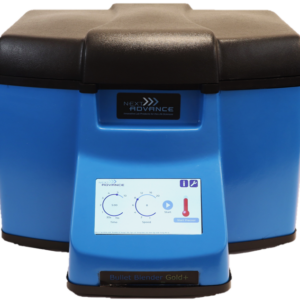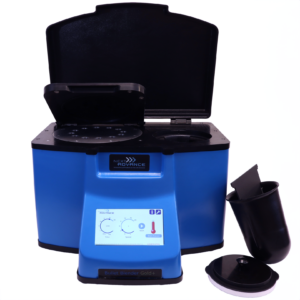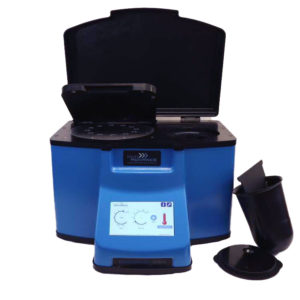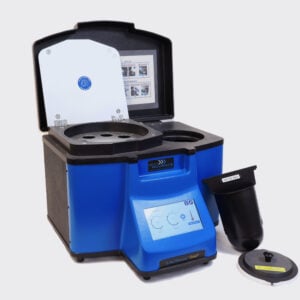Ideal for Insect Tissue Homogenization
Do you spend lots of time and effort homogenizing insect tissue samples? The Bullet Blender® tissue homogenizer delivers high quality and superior yields. No other homogenizer comes close to delivering the Bullet Blender’s winning combination of top-quality performance and budget-friendly affordability. See below for a insect tissue homogenization protocol.
Save Time, Effort and Get Superior Results with
The Bullet Blender Homogenizer
Consistent and High Yield Results
Run up to 24 samples at the same time under microprocessor-controlled conditions, ensuring experimental reproducibility and high yield. Process samples from 10mg or less up to 3.5g.No Cross Contamination
No part of the Bullet Blender ever touches the tissue – the sample tubes are kept closed during homogenization. There are no probes to clean between samples.Samples Stay Cool
The Bullet Blenders’ innovative and elegant design provides convective cooling of the samples, so they do not heat up more than several degrees. In fact, our Gold+ models hold the sample temperature to about 4ºC.Easy and Convenient to Use
Just place beads and buffer along with your tissue sample in standard tubes, load tubes directly in the Bullet Blender, select time and speed, and press start.Risk Free Purchase
Thousands of peer-reviewed journal articles attest to the consistency and quality of the Bullet Blender homogenizer. We offer a 2 year warranty, extendable to 4 years, because our Bullet Blenders are reliable and last for many years.Insect Tissue Homogenization Protocol
Sample size |
See the Protocol |
| microcentrifuge tube model (up to 300 mg) | Small insects (soft-bodied) samples |
| microcentrifuge tube model (up to 300 mg) | Small insects (light and hard) samples | </
What Else Can You Homogenize? Tough or Soft, No Problem!
The Bullet Blender can process a wide range of samples including organ tissue, cell culture, plant tissue, and small organisms. You can homogenize samples as tough as mouse femur or for gentle applications such as tissue dissociation or organelle isolation.

Want more guidance? Need a quote? Contact us:
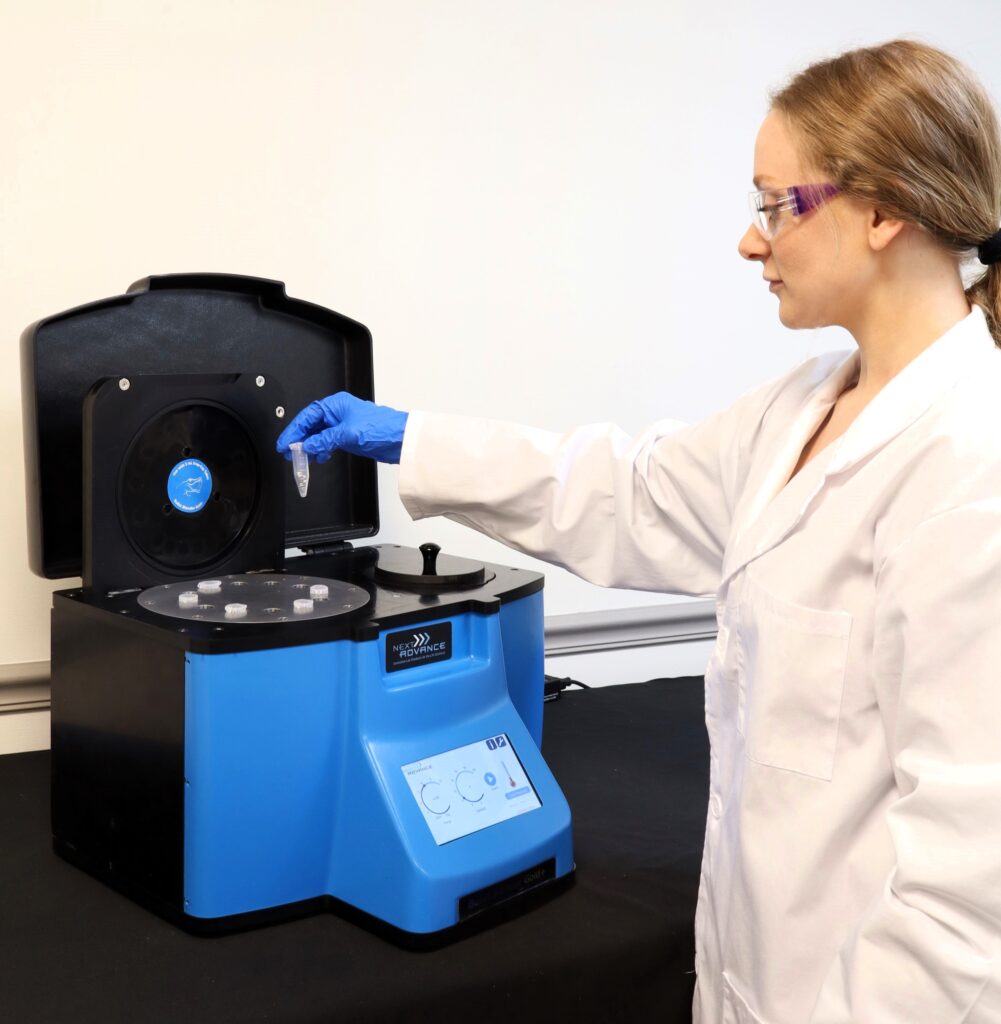
Bullet Blender Models
Select Publications using the Bullet Blender to Homogenize Insect Tissue
2474232
insects
1
apa
50
date
desc
3170
https://www.nextadvance.com/wp-content/plugins/zotpress/
%7B%22status%22%3A%22success%22%2C%22updateneeded%22%3Afalse%2C%22instance%22%3Afalse%2C%22meta%22%3A%7B%22request_last%22%3A0%2C%22request_next%22%3A0%2C%22used_cache%22%3Atrue%7D%2C%22data%22%3A%5B%7B%22key%22%3A%22ITWIV3SG%22%2C%22library%22%3A%7B%22id%22%3A2474232%7D%2C%22meta%22%3A%7B%22creatorSummary%22%3A%22Thangaraj%20et%20al.%22%2C%22parsedDate%22%3A%222016-03%22%2C%22numChildren%22%3A2%7D%2C%22bib%22%3A%22%26lt%3Bdiv%20class%3D%26quot%3Bcsl-bib-body%26quot%3B%20style%3D%26quot%3Bline-height%3A%202%3B%20padding-left%3A%201em%3B%20text-indent%3A-1em%3B%26quot%3B%26gt%3B%5Cn%20%20%26lt%3Bdiv%20class%3D%26quot%3Bcsl-entry%26quot%3B%26gt%3BThangaraj%2C%20S.%20R.%2C%20McCulloch%2C%20G.%20A.%2C%20Subbarayalu%2C%20M.%2C%20Subramaniam%2C%20C.%2C%20%26amp%3B%20Walter%2C%20G.%20H.%20%282016%29.%20Development%20of%20microsatellite%20markers%20and%20a%20preliminary%20assessment%20of%20population%20structuring%20in%20the%20rice%20weevil%2C%20Sitophilus%20oryzae%20%28L.%29.%20%26lt%3Bi%26gt%3BJournal%20of%20Stored%20Products%20Research%26lt%3B%5C%2Fi%26gt%3B%2C%20%26lt%3Bi%26gt%3B66%26lt%3B%5C%2Fi%26gt%3B%2C%2012%26%23x2013%3B17.%20%26lt%3Ba%20class%3D%26%23039%3Bzp-DOIURL%26%23039%3B%20href%3D%26%23039%3Bhttps%3A%5C%2F%5C%2Fdoi.org%5C%2F10.1016%5C%2Fj.jspr.2015.12.005%26%23039%3B%26gt%3Bhttps%3A%5C%2F%5C%2Fdoi.org%5C%2F10.1016%5C%2Fj.jspr.2015.12.005%26lt%3B%5C%2Fa%26gt%3B%26lt%3B%5C%2Fdiv%26gt%3B%5Cn%26lt%3B%5C%2Fdiv%26gt%3B%22%2C%22data%22%3A%7B%22itemType%22%3A%22journalArticle%22%2C%22title%22%3A%22Development%20of%20microsatellite%20markers%20and%20a%20preliminary%20assessment%20of%20population%20structuring%20in%20the%20rice%20weevil%2C%20Sitophilus%20oryzae%20%28L.%29%22%2C%22creators%22%3A%5B%7B%22creatorType%22%3A%22author%22%2C%22firstName%22%3A%22Sonai%20Rajan%22%2C%22lastName%22%3A%22Thangaraj%22%7D%2C%7B%22creatorType%22%3A%22author%22%2C%22firstName%22%3A%22Graham%20A.%22%2C%22lastName%22%3A%22McCulloch%22%7D%2C%7B%22creatorType%22%3A%22author%22%2C%22firstName%22%3A%22Mohankumar%22%2C%22lastName%22%3A%22Subbarayalu%22%7D%2C%7B%22creatorType%22%3A%22author%22%2C%22firstName%22%3A%22Chandrasekaran%22%2C%22lastName%22%3A%22Subramaniam%22%7D%2C%7B%22creatorType%22%3A%22author%22%2C%22firstName%22%3A%22Gimme%20H.%22%2C%22lastName%22%3A%22Walter%22%7D%5D%2C%22abstractNote%22%3A%22The%20rice%20weevil%2C%20Sitophilus%20oryzae%20is%20one%20of%20the%20primary%20pests%20of%20stored%20grains%20worldwide.%20To%20develop%20and%20implement%20an%20effective%20integrated%20pest%20management%20strategy%2C%20an%20understanding%20of%20the%20population%20structuring%20of%20this%20destructive%20pest%20is%20vital.%20In%20this%20study%20we%20used%20Illumina%20paired-end%20sequencing%20to%20develop%20S.%5Cu00a0oryzae%20species-specific%20microsatellite%20markers%2C%20and%20used%20these%20markers%20to%20conduct%20a%20preliminary%20assessment%20of%20population%20structuring%20in%20four%20populations%20of%20S.%5Cu00a0oryzae%20from%20three%20countries%20%28Australia%2C%20China%2C%20and%20USA%29.%207%2C635%2C996%20raw%20sequencing%20reads%20were%20produced%2C%20with%2011%2C794%20microsatellites%20detected%20and%20214%2C257%20primer%20options%20designed.%2048%20microsatellite%20markers%20were%20selected%20for%20further%20validation%2C%20with%2010%20markers%20amplifying%20consistently%20across%20the%20four%20S.%5Cu00a0oryzae%20populations.%20These%20markers%20displayed%20a%20high%20level%20of%20polymorphism%20overall%20%286.67%20alleles%5C%2Flocus%29%2C%20though%20this%20was%20slightly%20lower%20within%20populations%20%283.10%5Cu20134.88%20alleles%5C%2Flocus%29.%20We%20used%20the%20markers%20to%20conduct%20a%20preliminary%20assessment%20of%20genetic%20structuring%20among%20the%20four%20S.%5Cu00a0oryzae%20populations%3A%20three%20laboratory%20cultures%20%28New%20South%20Wales%2C%20Queensland%2C%20and%20Santai%29%20and%20a%20field%20collected%20population%20from%20Kansas.%20Analyses%20suggest%20high%20levels%20of%20genetic%20differentiation%20between%20the%20sample%20locations%2C%20with%20a%20global%20FST%20of%200.239%2C%20and%20pairwise%20FST%20values%20ranging%20from%200.100%20to%200.395.%20Bayesian%20clustering%20analyses%20suggest%20these%20four%20populations%20formed%20four%20distinct%20clusters%2C%20with%20a%20similar%20pattern%20identified%20by%20Principal%20Coordinate%20Analysis.%20These%20microsatellite%20markers%2C%20together%20with%20our%20preliminary%20population%20genetic%20analyses%2C%20will%20provide%20a%20valuable%20resource%20for%20population%20genetic%20research%2C%20and%20contribute%20to%20effective%20integrated%20pest%20management%20strategies%20in%20the%20future.%22%2C%22date%22%3A%22March%202016%22%2C%22language%22%3A%22%22%2C%22DOI%22%3A%2210.1016%5C%2Fj.jspr.2015.12.005%22%2C%22ISSN%22%3A%220022-474X%22%2C%22url%22%3A%22http%3A%5C%2F%5C%2Fwww.sciencedirect.com%5C%2Fscience%5C%2Farticle%5C%2Fpii%5C%2FS0022474X15300503%22%2C%22collections%22%3A%5B%22M2MNG549%22%5D%2C%22dateModified%22%3A%222016-06-24T15%3A50%3A21Z%22%7D%7D%2C%7B%22key%22%3A%22JGEAJTQ4%22%2C%22library%22%3A%7B%22id%22%3A2474232%7D%2C%22meta%22%3A%7B%22creatorSummary%22%3A%22Perkin%20et%20al.%22%2C%22parsedDate%22%3A%222016-01-18%22%2C%22numChildren%22%3A0%7D%2C%22bib%22%3A%22%26lt%3Bdiv%20class%3D%26quot%3Bcsl-bib-body%26quot%3B%20style%3D%26quot%3Bline-height%3A%202%3B%20padding-left%3A%201em%3B%20text-indent%3A-1em%3B%26quot%3B%26gt%3B%5Cn%20%20%26lt%3Bdiv%20class%3D%26quot%3Bcsl-entry%26quot%3B%26gt%3BPerkin%2C%20L.%2C%20Elpidina%2C%20E.%20N.%2C%20%26amp%3B%20Oppert%2C%20B.%20%282016%29.%20Expression%20patterns%20of%20cysteine%20peptidase%20genes%20across%20the%20%26lt%3Bi%26gt%3BTribolium%20castaneum%26lt%3B%5C%2Fi%26gt%3B%20life%20cycle%20provide%20clues%20to%20biological%20function.%20%26lt%3Bi%26gt%3BPeerJ%26lt%3B%5C%2Fi%26gt%3B%2C%20%26lt%3Bi%26gt%3B4%26lt%3B%5C%2Fi%26gt%3B%2C%20e1581.%20%26lt%3Ba%20class%3D%26%23039%3Bzp-DOIURL%26%23039%3B%20href%3D%26%23039%3Bhttps%3A%5C%2F%5C%2Fdoi.org%5C%2F10.7717%5C%2Fpeerj.1581%26%23039%3B%26gt%3Bhttps%3A%5C%2F%5C%2Fdoi.org%5C%2F10.7717%5C%2Fpeerj.1581%26lt%3B%5C%2Fa%26gt%3B%26lt%3B%5C%2Fdiv%26gt%3B%5Cn%26lt%3B%5C%2Fdiv%26gt%3B%22%2C%22data%22%3A%7B%22itemType%22%3A%22journalArticle%22%2C%22title%22%3A%22Expression%20patterns%20of%20cysteine%20peptidase%20genes%20across%20the%20%3Ci%3ETribolium%20castaneum%3C%5C%2Fi%3E%20life%20cycle%20provide%20clues%20to%20biological%20function%22%2C%22creators%22%3A%5B%7B%22creatorType%22%3A%22author%22%2C%22firstName%22%3A%22Lindsey%22%2C%22lastName%22%3A%22Perkin%22%7D%2C%7B%22creatorType%22%3A%22author%22%2C%22firstName%22%3A%22Elena%20N.%22%2C%22lastName%22%3A%22Elpidina%22%7D%2C%7B%22creatorType%22%3A%22author%22%2C%22firstName%22%3A%22Brenda%22%2C%22lastName%22%3A%22Oppert%22%7D%5D%2C%22abstractNote%22%3A%22%22%2C%22date%22%3A%222016-01-18%22%2C%22language%22%3A%22en%22%2C%22DOI%22%3A%2210.7717%5C%2Fpeerj.1581%22%2C%22ISSN%22%3A%222167-8359%22%2C%22url%22%3A%22https%3A%5C%2F%5C%2Fpeerj.com%5C%2Farticles%5C%2F1581%22%2C%22collections%22%3A%5B%22M2MNG549%22%5D%2C%22dateModified%22%3A%222016-06-24T17%3A38%3A56Z%22%7D%7D%2C%7B%22key%22%3A%223WU9HHV8%22%2C%22library%22%3A%7B%22id%22%3A2474232%7D%2C%22meta%22%3A%7B%22creatorSummary%22%3A%22Stanton-Geddes%20et%20al.%22%2C%22parsedDate%22%3A%222016%22%2C%22numChildren%22%3A2%7D%2C%22bib%22%3A%22%26lt%3Bdiv%20class%3D%26quot%3Bcsl-bib-body%26quot%3B%20style%3D%26quot%3Bline-height%3A%202%3B%20padding-left%3A%201em%3B%20text-indent%3A-1em%3B%26quot%3B%26gt%3B%5Cn%20%20%26lt%3Bdiv%20class%3D%26quot%3Bcsl-entry%26quot%3B%26gt%3BStanton-Geddes%2C%20J.%2C%20Nguyen%2C%20A.%2C%20Chick%2C%20L.%2C%20Vincent%2C%20J.%2C%20Vangala%2C%20M.%2C%20Dunn%2C%20R.%20R.%2C%20Ellison%2C%20A.%20M.%2C%20Sanders%2C%20N.%20J.%2C%20Gotelli%2C%20N.%20J.%2C%20%26amp%3B%20Cahan%2C%20S.%20H.%20%282016%29.%20Thermal%20reactionomes%20reveal%20divergent%20responses%20to%20thermal%20extremes%20in%20warm%20and%20cool-climate%20ant%20species.%20%26lt%3Bi%26gt%3BBMC%20Genomics%26lt%3B%5C%2Fi%26gt%3B%2C%20%26lt%3Bi%26gt%3B17%26lt%3B%5C%2Fi%26gt%3B%2C%20171.%20%26lt%3Ba%20class%3D%26%23039%3Bzp-DOIURL%26%23039%3B%20href%3D%26%23039%3Bhttps%3A%5C%2F%5C%2Fdoi.org%5C%2F10.1186%5C%2Fs12864-016-2466-z%26%23039%3B%26gt%3Bhttps%3A%5C%2F%5C%2Fdoi.org%5C%2F10.1186%5C%2Fs12864-016-2466-z%26lt%3B%5C%2Fa%26gt%3B%26lt%3B%5C%2Fdiv%26gt%3B%5Cn%26lt%3B%5C%2Fdiv%26gt%3B%22%2C%22data%22%3A%7B%22itemType%22%3A%22journalArticle%22%2C%22title%22%3A%22Thermal%20reactionomes%20reveal%20divergent%20responses%20to%20thermal%20extremes%20in%20warm%20and%20cool-climate%20ant%20species%22%2C%22creators%22%3A%5B%7B%22creatorType%22%3A%22author%22%2C%22firstName%22%3A%22John%22%2C%22lastName%22%3A%22Stanton-Geddes%22%7D%2C%7B%22creatorType%22%3A%22author%22%2C%22firstName%22%3A%22Andrew%22%2C%22lastName%22%3A%22Nguyen%22%7D%2C%7B%22creatorType%22%3A%22author%22%2C%22firstName%22%3A%22Lacy%22%2C%22lastName%22%3A%22Chick%22%7D%2C%7B%22creatorType%22%3A%22author%22%2C%22firstName%22%3A%22James%22%2C%22lastName%22%3A%22Vincent%22%7D%2C%7B%22creatorType%22%3A%22author%22%2C%22firstName%22%3A%22Mahesh%22%2C%22lastName%22%3A%22Vangala%22%7D%2C%7B%22creatorType%22%3A%22author%22%2C%22firstName%22%3A%22Robert%20R.%22%2C%22lastName%22%3A%22Dunn%22%7D%2C%7B%22creatorType%22%3A%22author%22%2C%22firstName%22%3A%22Aaron%20M.%22%2C%22lastName%22%3A%22Ellison%22%7D%2C%7B%22creatorType%22%3A%22author%22%2C%22firstName%22%3A%22Nathan%20J.%22%2C%22lastName%22%3A%22Sanders%22%7D%2C%7B%22creatorType%22%3A%22author%22%2C%22firstName%22%3A%22Nicholas%20J.%22%2C%22lastName%22%3A%22Gotelli%22%7D%2C%7B%22creatorType%22%3A%22author%22%2C%22firstName%22%3A%22Sara%20Helms%22%2C%22lastName%22%3A%22Cahan%22%7D%5D%2C%22abstractNote%22%3A%22The%20distributions%20of%20species%20and%20their%20responses%20to%20climate%20change%20are%20in%20part%20determined%20by%20their%20thermal%20tolerances.%20However%2C%20little%20is%20known%20about%20how%20thermal%20tolerance%20evolves.%20To%20test%20whether%20evolutionary%20extension%20of%20thermal%20limits%20is%20accomplished%20through%20enhanced%20cellular%20stress%20response%20%28enhanced%20response%29%2C%20constitutively%20elevated%20expression%20of%20protective%20genes%20%28genetic%20assimilation%29%20or%20a%20shift%20from%20damage%20resistance%20to%20passive%20mechanisms%20of%20thermal%20stability%20%28tolerance%29%2C%20we%20conducted%20an%20analysis%20of%20the%20reactionome%3A%20the%20reaction%20norm%20for%20all%20genes%20in%20an%20organism%5Cu2019s%20transcriptome%20measured%20across%20an%20experimental%20gradient.%20We%20characterized%20thermal%20reactionomes%20of%20two%20common%20ant%20species%20in%20the%20eastern%20U.S%2C%20the%20northern%20cool-climate%20Aphaenogaster%20picea%20and%20the%20southern%20warm-climate%20Aphaenogaster%20carolinensis%2C%20across%2012%20temperatures%20that%20spanned%20their%20entire%20thermal%20breadth.%22%2C%22date%22%3A%222016%22%2C%22language%22%3A%22%22%2C%22DOI%22%3A%2210.1186%5C%2Fs12864-016-2466-z%22%2C%22ISSN%22%3A%221471-2164%22%2C%22url%22%3A%22http%3A%5C%2F%5C%2Fdx.doi.org%5C%2F10.1186%5C%2Fs12864-016-2466-z%22%2C%22collections%22%3A%5B%22M2MNG549%22%5D%2C%22dateModified%22%3A%222016-06-10T19%3A16%3A29Z%22%7D%7D%2C%7B%22key%22%3A%22FQBC5DJA%22%2C%22library%22%3A%7B%22id%22%3A2474232%7D%2C%22meta%22%3A%7B%22creatorSummary%22%3A%22Nguyen%20et%20al.%22%2C%22parsedDate%22%3A%222016%22%2C%22numChildren%22%3A4%7D%2C%22bib%22%3A%22%26lt%3Bdiv%20class%3D%26quot%3Bcsl-bib-body%26quot%3B%20style%3D%26quot%3Bline-height%3A%202%3B%20padding-left%3A%201em%3B%20text-indent%3A-1em%3B%26quot%3B%26gt%3B%5Cn%20%20%26lt%3Bdiv%20class%3D%26quot%3Bcsl-entry%26quot%3B%26gt%3BNguyen%2C%20A.%20D.%2C%20Gotelli%2C%20N.%20J.%2C%20%26amp%3B%20Cahan%2C%20S.%20H.%20%282016%29.%20The%20evolution%20of%20heat%20shock%20protein%20sequences%2C%20cis-regulatory%20elements%2C%20and%20expression%20profiles%20in%20the%20eusocial%20Hymenoptera.%20%26lt%3Bi%26gt%3BBMC%20Evolutionary%20Biology%26lt%3B%5C%2Fi%26gt%3B%2C%20%26lt%3Bi%26gt%3B16%26lt%3B%5C%2Fi%26gt%3B%2C%2015.%20%26lt%3Ba%20class%3D%26%23039%3Bzp-DOIURL%26%23039%3B%20href%3D%26%23039%3Bhttps%3A%5C%2F%5C%2Fdoi.org%5C%2F10.1186%5C%2Fs12862-015-0573-0%26%23039%3B%26gt%3Bhttps%3A%5C%2F%5C%2Fdoi.org%5C%2F10.1186%5C%2Fs12862-015-0573-0%26lt%3B%5C%2Fa%26gt%3B%26lt%3B%5C%2Fdiv%26gt%3B%5Cn%26lt%3B%5C%2Fdiv%26gt%3B%22%2C%22data%22%3A%7B%22itemType%22%3A%22journalArticle%22%2C%22title%22%3A%22The%20evolution%20of%20heat%20shock%20protein%20sequences%2C%20cis-regulatory%20elements%2C%20and%20expression%20profiles%20in%20the%20eusocial%20Hymenoptera%22%2C%22creators%22%3A%5B%7B%22creatorType%22%3A%22author%22%2C%22firstName%22%3A%22Andrew%20D.%22%2C%22lastName%22%3A%22Nguyen%22%7D%2C%7B%22creatorType%22%3A%22author%22%2C%22firstName%22%3A%22Nicholas%20J.%22%2C%22lastName%22%3A%22Gotelli%22%7D%2C%7B%22creatorType%22%3A%22author%22%2C%22firstName%22%3A%22Sara%20Helms%22%2C%22lastName%22%3A%22Cahan%22%7D%5D%2C%22abstractNote%22%3A%22The%20eusocial%20Hymenoptera%20have%20radiated%20across%20a%20wide%20range%20of%20thermal%20environments%2C%20exposing%20them%20to%20significant%20physiological%20stressors.%20We%20reconstructed%20the%20evolutionary%20history%20of%20three%20families%20of%20Heat%20Shock%20Proteins%20%28Hsp90%2C%20Hsp70%2C%20Hsp40%29%2C%20the%20primary%20molecular%20chaperones%20protecting%20against%20thermal%20damage%2C%20across%2012%20Hymenopteran%20species%20and%20four%20other%20insect%20orders.%20We%20also%20predicted%20and%20tested%20for%20thermal%20inducibility%20of%20eight%20Hsps%20from%20the%20presence%20of%20cis-regulatory%20heat%20shock%20elements%20%28HSEs%29.%20We%20tested%20whether%20Hsp%20induction%20patterns%20in%20ants%20were%20associated%20with%20different%20thermal%20environments.%22%2C%22date%22%3A%222016%22%2C%22language%22%3A%22%22%2C%22DOI%22%3A%2210.1186%5C%2Fs12862-015-0573-0%22%2C%22ISSN%22%3A%221471-2148%22%2C%22url%22%3A%22http%3A%5C%2F%5C%2Fdx.doi.org%5C%2F10.1186%5C%2Fs12862-015-0573-0%22%2C%22collections%22%3A%5B%22M2MNG549%22%5D%2C%22dateModified%22%3A%222016-06-24T16%3A48%3A15Z%22%7D%7D%2C%7B%22key%22%3A%226U9KEKXP%22%2C%22library%22%3A%7B%22id%22%3A2474232%7D%2C%22meta%22%3A%7B%22creatorSummary%22%3A%22Fros%20et%20al.%22%2C%22parsedDate%22%3A%222015-07-30%22%2C%22numChildren%22%3A0%7D%2C%22bib%22%3A%22%26lt%3Bdiv%20class%3D%26quot%3Bcsl-bib-body%26quot%3B%20style%3D%26quot%3Bline-height%3A%202%3B%20padding-left%3A%201em%3B%20text-indent%3A-1em%3B%26quot%3B%26gt%3B%5Cn%20%20%26lt%3Bdiv%20class%3D%26quot%3Bcsl-entry%26quot%3B%26gt%3BFros%2C%20J.%20J.%2C%20Geertsema%2C%20C.%2C%20Vogels%2C%20C.%20B.%2C%20Roosjen%2C%20P.%20P.%2C%20Failloux%2C%20A.-B.%2C%20Vlak%2C%20J.%20M.%2C%20Koenraadt%2C%20C.%20J.%2C%20Takken%2C%20W.%2C%20%26amp%3B%20Pijlman%2C%20G.%20P.%20%282015%29.%20West%20Nile%20Virus%3A%20High%20Transmission%20Rate%20in%20North-Western%20European%20Mosquitoes%20Indicates%20Its%20Epidemic%20Potential%20and%20Warrants%20Increased%20Surveillance.%20%26lt%3Bi%26gt%3BPLOS%20Neglected%20Tropical%20Diseases%26lt%3B%5C%2Fi%26gt%3B%2C%20%26lt%3Bi%26gt%3B9%26lt%3B%5C%2Fi%26gt%3B%287%29%2C%20e0003956.%20%26lt%3Ba%20class%3D%26%23039%3Bzp-DOIURL%26%23039%3B%20href%3D%26%23039%3Bhttps%3A%5C%2F%5C%2Fdoi.org%5C%2F10.1371%5C%2Fjournal.pntd.0003956%26%23039%3B%26gt%3Bhttps%3A%5C%2F%5C%2Fdoi.org%5C%2F10.1371%5C%2Fjournal.pntd.0003956%26lt%3B%5C%2Fa%26gt%3B%26lt%3B%5C%2Fdiv%26gt%3B%5Cn%26lt%3B%5C%2Fdiv%26gt%3B%22%2C%22data%22%3A%7B%22itemType%22%3A%22journalArticle%22%2C%22title%22%3A%22West%20Nile%20Virus%3A%20High%20Transmission%20Rate%20in%20North-Western%20European%20Mosquitoes%20Indicates%20Its%20Epidemic%20Potential%20and%20Warrants%20Increased%20Surveillance%22%2C%22creators%22%3A%5B%7B%22creatorType%22%3A%22author%22%2C%22firstName%22%3A%22Jelke%20J.%22%2C%22lastName%22%3A%22Fros%22%7D%2C%7B%22creatorType%22%3A%22author%22%2C%22firstName%22%3A%22Corinne%22%2C%22lastName%22%3A%22Geertsema%22%7D%2C%7B%22creatorType%22%3A%22author%22%2C%22firstName%22%3A%22Chantal%20B.%22%2C%22lastName%22%3A%22Vogels%22%7D%2C%7B%22creatorType%22%3A%22author%22%2C%22firstName%22%3A%22Peter%20P.%22%2C%22lastName%22%3A%22Roosjen%22%7D%2C%7B%22creatorType%22%3A%22author%22%2C%22firstName%22%3A%22Anna-Bella%22%2C%22lastName%22%3A%22Failloux%22%7D%2C%7B%22creatorType%22%3A%22author%22%2C%22firstName%22%3A%22Just%20M.%22%2C%22lastName%22%3A%22Vlak%22%7D%2C%7B%22creatorType%22%3A%22author%22%2C%22firstName%22%3A%22Constantianus%20J.%22%2C%22lastName%22%3A%22Koenraadt%22%7D%2C%7B%22creatorType%22%3A%22author%22%2C%22firstName%22%3A%22Willem%22%2C%22lastName%22%3A%22Takken%22%7D%2C%7B%22creatorType%22%3A%22author%22%2C%22firstName%22%3A%22Gorben%20P.%22%2C%22lastName%22%3A%22Pijlman%22%7D%2C%7B%22creatorType%22%3A%22editor%22%2C%22firstName%22%3A%22Song%22%2C%22lastName%22%3A%22Liang%22%7D%5D%2C%22abstractNote%22%3A%22%22%2C%22date%22%3A%222015-7-30%22%2C%22language%22%3A%22en%22%2C%22DOI%22%3A%2210.1371%5C%2Fjournal.pntd.0003956%22%2C%22ISSN%22%3A%221935-2735%22%2C%22url%22%3A%22http%3A%5C%2F%5C%2Fdx.plos.org%5C%2F10.1371%5C%2Fjournal.pntd.0003956%22%2C%22collections%22%3A%5B%22M2MNG549%22%5D%2C%22dateModified%22%3A%222015-12-30T18%3A11%3A40Z%22%7D%7D%2C%7B%22key%22%3A%22INP3XFH5%22%2C%22library%22%3A%7B%22id%22%3A2474232%7D%2C%22meta%22%3A%7B%22creatorSummary%22%3A%22Blenkiron%20et%20al.%22%2C%22parsedDate%22%3A%222015-03-24%22%2C%22numChildren%22%3A0%7D%2C%22bib%22%3A%22%26lt%3Bdiv%20class%3D%26quot%3Bcsl-bib-body%26quot%3B%20style%3D%26quot%3Bline-height%3A%202%3B%20padding-left%3A%201em%3B%20text-indent%3A-1em%3B%26quot%3B%26gt%3B%5Cn%20%20%26lt%3Bdiv%20class%3D%26quot%3Bcsl-entry%26quot%3B%26gt%3BBlenkiron%2C%20C.%2C%20Tsai%2C%20P.%2C%20Brown%2C%20L.%20A.%2C%20Tintinger%2C%20V.%2C%20Askelund%2C%20K.%20J.%2C%20Windsor%2C%20J.%20A.%2C%20%26amp%3B%20Phillips%2C%20A.%20R.%20%282015%29.%20Characterisation%20of%20the%20Small%20RNAs%20in%20the%20Biomedically%20Important%20Green-Bottle%20Blowfly%20Lucilia%20sericata.%20%26lt%3Bi%26gt%3BPLOS%20ONE%26lt%3B%5C%2Fi%26gt%3B%2C%20%26lt%3Bi%26gt%3B10%26lt%3B%5C%2Fi%26gt%3B%283%29%2C%20e0122203.%20%26lt%3Ba%20class%3D%26%23039%3Bzp-DOIURL%26%23039%3B%20href%3D%26%23039%3Bhttps%3A%5C%2F%5C%2Fdoi.org%5C%2F10.1371%5C%2Fjournal.pone.0122203%26%23039%3B%26gt%3Bhttps%3A%5C%2F%5C%2Fdoi.org%5C%2F10.1371%5C%2Fjournal.pone.0122203%26lt%3B%5C%2Fa%26gt%3B%26lt%3B%5C%2Fdiv%26gt%3B%5Cn%26lt%3B%5C%2Fdiv%26gt%3B%22%2C%22data%22%3A%7B%22itemType%22%3A%22journalArticle%22%2C%22title%22%3A%22Characterisation%20of%20the%20Small%20RNAs%20in%20the%20Biomedically%20Important%20Green-Bottle%20Blowfly%20Lucilia%20sericata%22%2C%22creators%22%3A%5B%7B%22creatorType%22%3A%22author%22%2C%22firstName%22%3A%22Cherie%22%2C%22lastName%22%3A%22Blenkiron%22%7D%2C%7B%22creatorType%22%3A%22author%22%2C%22firstName%22%3A%22Peter%22%2C%22lastName%22%3A%22Tsai%22%7D%2C%7B%22creatorType%22%3A%22author%22%2C%22firstName%22%3A%22Lisa%20A.%22%2C%22lastName%22%3A%22Brown%22%7D%2C%7B%22creatorType%22%3A%22author%22%2C%22firstName%22%3A%22Vernon%22%2C%22lastName%22%3A%22Tintinger%22%7D%2C%7B%22creatorType%22%3A%22author%22%2C%22firstName%22%3A%22Kathryn%20J.%22%2C%22lastName%22%3A%22Askelund%22%7D%2C%7B%22creatorType%22%3A%22author%22%2C%22firstName%22%3A%22John%20A.%22%2C%22lastName%22%3A%22Windsor%22%7D%2C%7B%22creatorType%22%3A%22author%22%2C%22firstName%22%3A%22Anthony%20R.%22%2C%22lastName%22%3A%22Phillips%22%7D%2C%7B%22creatorType%22%3A%22editor%22%2C%22firstName%22%3A%22Yun%22%2C%22lastName%22%3A%22Zheng%22%7D%5D%2C%22abstractNote%22%3A%22%22%2C%22date%22%3A%222015-3-24%22%2C%22language%22%3A%22en%22%2C%22DOI%22%3A%2210.1371%5C%2Fjournal.pone.0122203%22%2C%22ISSN%22%3A%221932-6203%22%2C%22url%22%3A%22http%3A%5C%2F%5C%2Fdx.plos.org%5C%2F10.1371%5C%2Fjournal.pone.0122203%22%2C%22collections%22%3A%5B%22M2MNG549%22%5D%2C%22dateModified%22%3A%222015-10-30T20%3A12%3A47Z%22%7D%7D%2C%7B%22key%22%3A%22XZHNP74C%22%2C%22library%22%3A%7B%22id%22%3A2474232%7D%2C%22meta%22%3A%7B%22creatorSummary%22%3A%22Osborne%20et%20al.%22%2C%22parsedDate%22%3A%222015-03-01%22%2C%22numChildren%22%3A0%7D%2C%22bib%22%3A%22%26lt%3Bdiv%20class%3D%26quot%3Bcsl-bib-body%26quot%3B%20style%3D%26quot%3Bline-height%3A%202%3B%20padding-left%3A%201em%3B%20text-indent%3A-1em%3B%26quot%3B%26gt%3B%5Cn%20%20%26lt%3Bdiv%20class%3D%26quot%3Bcsl-entry%26quot%3B%26gt%3BOsborne%2C%20C.%20J.%2C%20Mayo%2C%20C.%20E.%2C%20Mullens%2C%20B.%20A.%2C%20McDermott%2C%20E.%20G.%2C%20Gerry%2C%20A.%20C.%2C%20Reisen%2C%20W.%20K.%2C%20%26amp%3B%20MacLachlan%2C%20N.%20J.%20%282015%29.%20Lack%20of%20Evidence%20for%20Laboratory%20and%20Natural%20Vertical%20Transmission%20of%20Bluetongue%20Virus%20in%20Culicoides%20sonorensis%20%28Diptera%3A%20Ceratopogonidae%29.%20%26lt%3Bi%26gt%3BJournal%20of%20Medical%20Entomology%26lt%3B%5C%2Fi%26gt%3B%2C%20%26lt%3Bi%26gt%3B52%26lt%3B%5C%2Fi%26gt%3B%282%29%2C%20274%26%23x2013%3B277.%20%26lt%3Ba%20class%3D%26%23039%3Bzp-DOIURL%26%23039%3B%20href%3D%26%23039%3Bhttps%3A%5C%2F%5C%2Fdoi.org%5C%2F10.1093%5C%2Fjme%5C%2Ftju063%26%23039%3B%26gt%3Bhttps%3A%5C%2F%5C%2Fdoi.org%5C%2F10.1093%5C%2Fjme%5C%2Ftju063%26lt%3B%5C%2Fa%26gt%3B%26lt%3B%5C%2Fdiv%26gt%3B%5Cn%26lt%3B%5C%2Fdiv%26gt%3B%22%2C%22data%22%3A%7B%22itemType%22%3A%22journalArticle%22%2C%22title%22%3A%22Lack%20of%20Evidence%20for%20Laboratory%20and%20Natural%20Vertical%20Transmission%20of%20Bluetongue%20Virus%20in%20Culicoides%20sonorensis%20%28Diptera%3A%20Ceratopogonidae%29%22%2C%22creators%22%3A%5B%7B%22creatorType%22%3A%22author%22%2C%22firstName%22%3A%22C.%20J.%22%2C%22lastName%22%3A%22Osborne%22%7D%2C%7B%22creatorType%22%3A%22author%22%2C%22firstName%22%3A%22C.%20E.%22%2C%22lastName%22%3A%22Mayo%22%7D%2C%7B%22creatorType%22%3A%22author%22%2C%22firstName%22%3A%22B.%20A.%22%2C%22lastName%22%3A%22Mullens%22%7D%2C%7B%22creatorType%22%3A%22author%22%2C%22firstName%22%3A%22E.%20G.%22%2C%22lastName%22%3A%22McDermott%22%7D%2C%7B%22creatorType%22%3A%22author%22%2C%22firstName%22%3A%22A.%20C.%22%2C%22lastName%22%3A%22Gerry%22%7D%2C%7B%22creatorType%22%3A%22author%22%2C%22firstName%22%3A%22W.%20K.%22%2C%22lastName%22%3A%22Reisen%22%7D%2C%7B%22creatorType%22%3A%22author%22%2C%22firstName%22%3A%22N.%20J.%22%2C%22lastName%22%3A%22MacLachlan%22%7D%5D%2C%22abstractNote%22%3A%22%22%2C%22date%22%3A%222015-03-01%22%2C%22language%22%3A%22en%22%2C%22DOI%22%3A%2210.1093%5C%2Fjme%5C%2Ftju063%22%2C%22ISSN%22%3A%220022-2585%2C%201938-2928%22%2C%22url%22%3A%22http%3A%5C%2F%5C%2Fjme.oxfordjournals.org%5C%2Fcgi%5C%2Fdoi%5C%2F10.1093%5C%2Fjme%5C%2Ftju063%22%2C%22collections%22%3A%5B%22M2MNG549%22%5D%2C%22dateModified%22%3A%222015-08-05T17%3A37%3A03Z%22%7D%7D%2C%7B%22key%22%3A%22NRQJ5H5Z%22%2C%22library%22%3A%7B%22id%22%3A2474232%7D%2C%22meta%22%3A%7B%22creatorSummary%22%3A%22Herter%20et%20al.%22%2C%22parsedDate%22%3A%222015%22%2C%22numChildren%22%3A0%7D%2C%22bib%22%3A%22%26lt%3Bdiv%20class%3D%26quot%3Bcsl-bib-body%26quot%3B%20style%3D%26quot%3Bline-height%3A%202%3B%20padding-left%3A%201em%3B%20text-indent%3A-1em%3B%26quot%3B%26gt%3B%5Cn%20%20%26lt%3Bdiv%20class%3D%26quot%3Bcsl-entry%26quot%3B%26gt%3BHerter%2C%20E.%20K.%2C%20Stauch%2C%20M.%2C%20Gallant%2C%20M.%2C%20Wolf%2C%20E.%2C%20Raabe%2C%20T.%2C%20%26amp%3B%20Gallant%2C%20P.%20%282015%29.%20snoRNAs%20are%20a%20novel%20class%20of%20biologically%20relevant%20Myc%20targets.%20%26lt%3Bi%26gt%3BBMC%20Biology%26lt%3B%5C%2Fi%26gt%3B%2C%20%26lt%3Bi%26gt%3B13%26lt%3B%5C%2Fi%26gt%3B%281%29.%20%26lt%3Ba%20class%3D%26%23039%3Bzp-DOIURL%26%23039%3B%20href%3D%26%23039%3Bhttps%3A%5C%2F%5C%2Fdoi.org%5C%2F10.1186%5C%2Fs12915-015-0132-6%26%23039%3B%26gt%3Bhttps%3A%5C%2F%5C%2Fdoi.org%5C%2F10.1186%5C%2Fs12915-015-0132-6%26lt%3B%5C%2Fa%26gt%3B%26lt%3B%5C%2Fdiv%26gt%3B%5Cn%26lt%3B%5C%2Fdiv%26gt%3B%22%2C%22data%22%3A%7B%22itemType%22%3A%22journalArticle%22%2C%22title%22%3A%22snoRNAs%20are%20a%20novel%20class%20of%20biologically%20relevant%20Myc%20targets%22%2C%22creators%22%3A%5B%7B%22creatorType%22%3A%22author%22%2C%22firstName%22%3A%22Eva%20K%22%2C%22lastName%22%3A%22Herter%22%7D%2C%7B%22creatorType%22%3A%22author%22%2C%22firstName%22%3A%22Maria%22%2C%22lastName%22%3A%22Stauch%22%7D%2C%7B%22creatorType%22%3A%22author%22%2C%22firstName%22%3A%22Maria%22%2C%22lastName%22%3A%22Gallant%22%7D%2C%7B%22creatorType%22%3A%22author%22%2C%22firstName%22%3A%22Elmar%22%2C%22lastName%22%3A%22Wolf%22%7D%2C%7B%22creatorType%22%3A%22author%22%2C%22firstName%22%3A%22Thomas%22%2C%22lastName%22%3A%22Raabe%22%7D%2C%7B%22creatorType%22%3A%22author%22%2C%22firstName%22%3A%22Peter%22%2C%22lastName%22%3A%22Gallant%22%7D%5D%2C%22abstractNote%22%3A%22%22%2C%22date%22%3A%2212%5C%2F2015%22%2C%22language%22%3A%22en%22%2C%22DOI%22%3A%2210.1186%5C%2Fs12915-015-0132-6%22%2C%22ISSN%22%3A%221741-7007%22%2C%22url%22%3A%22http%3A%5C%2F%5C%2Fwww.biomedcentral.com%5C%2F1741-7007%5C%2F13%5C%2F25%22%2C%22collections%22%3A%5B%22M2MNG549%22%5D%2C%22dateModified%22%3A%222016-01-04T22%3A10%3A22Z%22%7D%7D%2C%7B%22key%22%3A%22IVUZVFPC%22%2C%22library%22%3A%7B%22id%22%3A2474232%7D%2C%22meta%22%3A%7B%22creatorSummary%22%3A%22Fros%20et%20al.%22%2C%22parsedDate%22%3A%222015%22%2C%22numChildren%22%3A0%7D%2C%22bib%22%3A%22%26lt%3Bdiv%20class%3D%26quot%3Bcsl-bib-body%26quot%3B%20style%3D%26quot%3Bline-height%3A%202%3B%20padding-left%3A%201em%3B%20text-indent%3A-1em%3B%26quot%3B%26gt%3B%5Cn%20%20%26lt%3Bdiv%20class%3D%26quot%3Bcsl-entry%26quot%3B%26gt%3BFros%2C%20J.%20J.%2C%20Miesen%2C%20P.%2C%20Vogels%2C%20C.%20B.%2C%20Gaibani%2C%20P.%2C%20Sambri%2C%20V.%2C%20Martina%2C%20B.%20E.%2C%20Koenraadt%2C%20C.%20J.%2C%20van%20Rij%2C%20R.%20P.%2C%20Vlak%2C%20J.%20M.%2C%20Takken%2C%20W.%2C%20%26amp%3B%20Pijlman%2C%20G.%20P.%20%282015%29.%20Comparative%20Usutu%20and%20West%20Nile%20virus%20transmission%20potential%20by%20local%20Culex%20pipiens%20mosquitoes%20in%20north-western%20Europe.%20%26lt%3Bi%26gt%3BOne%20Health%26lt%3B%5C%2Fi%26gt%3B%2C%20%26lt%3Bi%26gt%3B1%26lt%3B%5C%2Fi%26gt%3B%2C%2031%26%23x2013%3B36.%20%26lt%3Ba%20class%3D%26%23039%3Bzp-DOIURL%26%23039%3B%20href%3D%26%23039%3Bhttps%3A%5C%2F%5C%2Fdoi.org%5C%2F10.1016%5C%2Fj.onehlt.2015.08.002%26%23039%3B%26gt%3Bhttps%3A%5C%2F%5C%2Fdoi.org%5C%2F10.1016%5C%2Fj.onehlt.2015.08.002%26lt%3B%5C%2Fa%26gt%3B%26lt%3B%5C%2Fdiv%26gt%3B%5Cn%26lt%3B%5C%2Fdiv%26gt%3B%22%2C%22data%22%3A%7B%22itemType%22%3A%22journalArticle%22%2C%22title%22%3A%22Comparative%20Usutu%20and%20West%20Nile%20virus%20transmission%20potential%20by%20local%20Culex%20pipiens%20mosquitoes%20in%20north-western%20Europe%22%2C%22creators%22%3A%5B%7B%22creatorType%22%3A%22author%22%2C%22firstName%22%3A%22Jelke%20J.%22%2C%22lastName%22%3A%22Fros%22%7D%2C%7B%22creatorType%22%3A%22author%22%2C%22firstName%22%3A%22Pascal%22%2C%22lastName%22%3A%22Miesen%22%7D%2C%7B%22creatorType%22%3A%22author%22%2C%22firstName%22%3A%22Chantal%20B.%22%2C%22lastName%22%3A%22Vogels%22%7D%2C%7B%22creatorType%22%3A%22author%22%2C%22firstName%22%3A%22Paolo%22%2C%22lastName%22%3A%22Gaibani%22%7D%2C%7B%22creatorType%22%3A%22author%22%2C%22firstName%22%3A%22Vittorio%22%2C%22lastName%22%3A%22Sambri%22%7D%2C%7B%22creatorType%22%3A%22author%22%2C%22firstName%22%3A%22Byron%20E.%22%2C%22lastName%22%3A%22Martina%22%7D%2C%7B%22creatorType%22%3A%22author%22%2C%22firstName%22%3A%22Constantianus%20J.%22%2C%22lastName%22%3A%22Koenraadt%22%7D%2C%7B%22creatorType%22%3A%22author%22%2C%22firstName%22%3A%22Ronald%20P.%22%2C%22lastName%22%3A%22van%20Rij%22%7D%2C%7B%22creatorType%22%3A%22author%22%2C%22firstName%22%3A%22Just%20M.%22%2C%22lastName%22%3A%22Vlak%22%7D%2C%7B%22creatorType%22%3A%22author%22%2C%22firstName%22%3A%22Willem%22%2C%22lastName%22%3A%22Takken%22%7D%2C%7B%22creatorType%22%3A%22author%22%2C%22firstName%22%3A%22Gorben%20P.%22%2C%22lastName%22%3A%22Pijlman%22%7D%5D%2C%22abstractNote%22%3A%22%22%2C%22date%22%3A%2212%5C%2F2015%22%2C%22language%22%3A%22en%22%2C%22DOI%22%3A%2210.1016%5C%2Fj.onehlt.2015.08.002%22%2C%22ISSN%22%3A%2223527714%22%2C%22url%22%3A%22http%3A%5C%2F%5C%2Flinkinghub.elsevier.com%5C%2Fretrieve%5C%2Fpii%5C%2FS2352771415000063%22%2C%22collections%22%3A%5B%22M2MNG549%22%5D%2C%22dateModified%22%3A%222015-10-30T19%3A37%3A57Z%22%7D%7D%2C%7B%22key%22%3A%22RAA433FS%22%2C%22library%22%3A%7B%22id%22%3A2474232%7D%2C%22meta%22%3A%7B%22creatorSummary%22%3A%22Chick%22%2C%22parsedDate%22%3A%222015%22%2C%22numChildren%22%3A0%7D%2C%22bib%22%3A%22%26lt%3Bdiv%20class%3D%26quot%3Bcsl-bib-body%26quot%3B%20style%3D%26quot%3Bline-height%3A%202%3B%20padding-left%3A%201em%3B%20text-indent%3A-1em%3B%26quot%3B%26gt%3B%5Cn%20%20%26lt%3Bdiv%20class%3D%26quot%3Bcsl-entry%26quot%3B%26gt%3BChick%2C%20L.%20%282015%29.%20%26lt%3Bi%26gt%3BLinking%20physiology%20and%20biogeography%3A%20Disentangling%20the%20constraints%20on%20the%20distributions%20of%20ant%20species%26lt%3B%5C%2Fi%26gt%3B%20%5BUniversity%20of%20Tennessee-Knoxville%5D.%20%26lt%3Ba%20class%3D%26%23039%3Bzp-ItemURL%26%23039%3B%20href%3D%26%23039%3Bhttp%3A%5C%2F%5C%2Ftrace.tennessee.edu%5C%2Fcgi%5C%2Fviewcontent.cgi%3Farticle%3D4928%26amp%3Bcontext%3Dutk_graddiss%26%23039%3B%26gt%3Bhttp%3A%5C%2F%5C%2Ftrace.tennessee.edu%5C%2Fcgi%5C%2Fviewcontent.cgi%3Farticle%3D4928%26amp%3Bcontext%3Dutk_graddiss%26lt%3B%5C%2Fa%26gt%3B%26lt%3B%5C%2Fdiv%26gt%3B%5Cn%26lt%3B%5C%2Fdiv%26gt%3B%22%2C%22data%22%3A%7B%22itemType%22%3A%22thesis%22%2C%22title%22%3A%22Linking%20physiology%20and%20biogeography%3A%20Disentangling%20the%20constraints%20on%20the%20distributions%20of%20ant%20species%22%2C%22creators%22%3A%5B%7B%22creatorType%22%3A%22author%22%2C%22firstName%22%3A%22Lacy%22%2C%22lastName%22%3A%22Chick%22%7D%5D%2C%22abstractNote%22%3A%22%22%2C%22thesisType%22%3A%22%22%2C%22university%22%3A%22University%20of%20Tennessee-Knoxville%22%2C%22date%22%3A%2212-2015%22%2C%22language%22%3A%22%22%2C%22url%22%3A%22http%3A%5C%2F%5C%2Ftrace.tennessee.edu%5C%2Fcgi%5C%2Fviewcontent.cgi%3Farticle%3D4928%26context%3Dutk_graddiss%22%2C%22collections%22%3A%5B%22M2MNG549%22%5D%2C%22dateModified%22%3A%222016-01-11T21%3A17%3A52Z%22%7D%7D%2C%7B%22key%22%3A%226X389DA8%22%2C%22library%22%3A%7B%22id%22%3A2474232%7D%2C%22meta%22%3A%7B%22creatorSummary%22%3A%22Kwon%20et%20al.%22%2C%22parsedDate%22%3A%222015%22%2C%22numChildren%22%3A2%7D%2C%22bib%22%3A%22%26lt%3Bdiv%20class%3D%26quot%3Bcsl-bib-body%26quot%3B%20style%3D%26quot%3Bline-height%3A%202%3B%20padding-left%3A%201em%3B%20text-indent%3A-1em%3B%26quot%3B%26gt%3B%5Cn%20%20%26lt%3Bdiv%20class%3D%26quot%3Bcsl-entry%26quot%3B%26gt%3BKwon%2C%20D.%20H.%2C%20Park%2C%20J.%20H.%2C%20Ashok%2C%20P.%20A.%2C%20Lee%2C%20U.%2C%20%26amp%3B%20Lee%2C%20S.%20H.%20%282015%29.%20Screening%20of%20target%20genes%20for%20RNAi%20in%20Tetranychus%20urticae%20and%20RNAi%20toxicity%20enhancement%20by%20chimeric%20genes.%20%26lt%3Bi%26gt%3BPesticide%20Biochemistry%20and%20Physiology%26lt%3B%5C%2Fi%26gt%3B.%20%26lt%3Ba%20class%3D%26%23039%3Bzp-DOIURL%26%23039%3B%20href%3D%26%23039%3Bhttps%3A%5C%2F%5C%2Fdoi.org%5C%2F10.1016%5C%2Fj.pestbp.2015.11.005%26%23039%3B%26gt%3Bhttps%3A%5C%2F%5C%2Fdoi.org%5C%2F10.1016%5C%2Fj.pestbp.2015.11.005%26lt%3B%5C%2Fa%26gt%3B%26lt%3B%5C%2Fdiv%26gt%3B%5Cn%26lt%3B%5C%2Fdiv%26gt%3B%22%2C%22data%22%3A%7B%22itemType%22%3A%22journalArticle%22%2C%22title%22%3A%22Screening%20of%20target%20genes%20for%20RNAi%20in%20Tetranychus%20urticae%20and%20RNAi%20toxicity%20enhancement%20by%20chimeric%20genes%22%2C%22creators%22%3A%5B%7B%22creatorType%22%3A%22author%22%2C%22firstName%22%3A%22Deok%20Ho%22%2C%22lastName%22%3A%22Kwon%22%7D%2C%7B%22creatorType%22%3A%22author%22%2C%22firstName%22%3A%22Ji%20Hyun%22%2C%22lastName%22%3A%22Park%22%7D%2C%7B%22creatorType%22%3A%22author%22%2C%22firstName%22%3A%22Patil%20Anandrao%22%2C%22lastName%22%3A%22Ashok%22%7D%2C%7B%22creatorType%22%3A%22author%22%2C%22firstName%22%3A%22Unggyu%22%2C%22lastName%22%3A%22Lee%22%7D%2C%7B%22creatorType%22%3A%22author%22%2C%22firstName%22%3A%22Si%20Hyeock%22%2C%22lastName%22%3A%22Lee%22%7D%5D%2C%22abstractNote%22%3A%22%22%2C%22date%22%3A%2211%5C%2F2015%22%2C%22language%22%3A%22en%22%2C%22DOI%22%3A%2210.1016%5C%2Fj.pestbp.2015.11.005%22%2C%22ISSN%22%3A%2200483575%22%2C%22url%22%3A%22http%3A%5C%2F%5C%2Flinkinghub.elsevier.com%5C%2Fretrieve%5C%2Fpii%5C%2FS0048357515300651%22%2C%22collections%22%3A%5B%22M2MNG549%22%5D%2C%22dateModified%22%3A%222016-06-24T15%3A38%3A06Z%22%7D%7D%2C%7B%22key%22%3A%22PQMBAG3G%22%2C%22library%22%3A%7B%22id%22%3A2474232%7D%2C%22meta%22%3A%7B%22creatorSummary%22%3A%22Marshall%20and%20Sinclair%22%2C%22parsedDate%22%3A%222015%22%2C%22numChildren%22%3A0%7D%2C%22bib%22%3A%22%26lt%3Bdiv%20class%3D%26quot%3Bcsl-bib-body%26quot%3B%20style%3D%26quot%3Bline-height%3A%202%3B%20padding-left%3A%201em%3B%20text-indent%3A-1em%3B%26quot%3B%26gt%3B%5Cn%20%20%26lt%3Bdiv%20class%3D%26quot%3Bcsl-entry%26quot%3B%26gt%3BMarshall%2C%20K.%20E.%2C%20%26amp%3B%20Sinclair%2C%20B.%20J.%20%282015%29.%20The%20relative%20importance%20of%20number%2C%20duration%20and%20intensity%20of%20cold%20stress%20events%20in%20determining%20survival%20and%20energetics%20of%20an%20overwintering%20insect.%20%26lt%3Bi%26gt%3BFunctional%20Ecology%26lt%3B%5C%2Fi%26gt%3B%2C%20%26lt%3Bi%26gt%3B29%26lt%3B%5C%2Fi%26gt%3B%283%29%2C%20357%26%23x2013%3B366.%20%26lt%3Ba%20class%3D%26%23039%3Bzp-DOIURL%26%23039%3B%20href%3D%26%23039%3Bhttps%3A%5C%2F%5C%2Fdoi.org%5C%2F10.1111%5C%2F1365-2435.12328%26%23039%3B%26gt%3Bhttps%3A%5C%2F%5C%2Fdoi.org%5C%2F10.1111%5C%2F1365-2435.12328%26lt%3B%5C%2Fa%26gt%3B%26lt%3B%5C%2Fdiv%26gt%3B%5Cn%26lt%3B%5C%2Fdiv%26gt%3B%22%2C%22data%22%3A%7B%22itemType%22%3A%22journalArticle%22%2C%22title%22%3A%22The%20relative%20importance%20of%20number%2C%20duration%20and%20intensity%20of%20cold%20stress%20events%20in%20determining%20survival%20and%20energetics%20of%20an%20overwintering%20insect%22%2C%22creators%22%3A%5B%7B%22creatorType%22%3A%22author%22%2C%22firstName%22%3A%22Katie%20E.%22%2C%22lastName%22%3A%22Marshall%22%7D%2C%7B%22creatorType%22%3A%22author%22%2C%22firstName%22%3A%22Brent%20J.%22%2C%22lastName%22%3A%22Sinclair%22%7D%2C%7B%22creatorType%22%3A%22editor%22%2C%22firstName%22%3A%22Kwang%20Pum%22%2C%22lastName%22%3A%22Lee%22%7D%5D%2C%22abstractNote%22%3A%22%22%2C%22date%22%3A%2203%5C%2F2015%22%2C%22language%22%3A%22en%22%2C%22DOI%22%3A%2210.1111%5C%2F1365-2435.12328%22%2C%22ISSN%22%3A%2202698463%22%2C%22url%22%3A%22http%3A%5C%2F%5C%2Fdoi.wiley.com%5C%2F10.1111%5C%2F1365-2435.12328%22%2C%22collections%22%3A%5B%22M2MNG549%22%5D%2C%22dateModified%22%3A%222015-12-31T18%3A25%3A40Z%22%7D%7D%2C%7B%22key%22%3A%22A8V752DH%22%2C%22library%22%3A%7B%22id%22%3A2474232%7D%2C%22meta%22%3A%7B%22creatorSummary%22%3A%22Luo%20et%20al.%22%2C%22parsedDate%22%3A%222015%22%2C%22numChildren%22%3A0%7D%2C%22bib%22%3A%22%26lt%3Bdiv%20class%3D%26quot%3Bcsl-bib-body%26quot%3B%20style%3D%26quot%3Bline-height%3A%202%3B%20padding-left%3A%201em%3B%20text-indent%3A-1em%3B%26quot%3B%26gt%3B%5Cn%20%20%26lt%3Bdiv%20class%3D%26quot%3Bcsl-entry%26quot%3B%26gt%3BLuo%2C%20S.%2C%20Ahola%2C%20V.%2C%20Shu%2C%20C.%2C%20Xu%2C%20C.%2C%20%26amp%3B%20Wang%2C%20R.%20%282015%29.%20Heat%20shock%20protein%2070%20gene%20family%20in%20the%20Glanville%20fritillary%20butterfly%20and%20their%20response%20to%20thermal%20stress.%20%26lt%3Bi%26gt%3BGene%26lt%3B%5C%2Fi%26gt%3B%2C%20%26lt%3Bi%26gt%3B556%26lt%3B%5C%2Fi%26gt%3B%282%29%2C%20132%26%23x2013%3B141.%20%26lt%3Ba%20class%3D%26%23039%3Bzp-DOIURL%26%23039%3B%20href%3D%26%23039%3Bhttps%3A%5C%2F%5C%2Fdoi.org%5C%2F10.1016%5C%2Fj.gene.2014.11.043%26%23039%3B%26gt%3Bhttps%3A%5C%2F%5C%2Fdoi.org%5C%2F10.1016%5C%2Fj.gene.2014.11.043%26lt%3B%5C%2Fa%26gt%3B%26lt%3B%5C%2Fdiv%26gt%3B%5Cn%26lt%3B%5C%2Fdiv%26gt%3B%22%2C%22data%22%3A%7B%22itemType%22%3A%22journalArticle%22%2C%22title%22%3A%22Heat%20shock%20protein%2070%20gene%20family%20in%20the%20Glanville%20fritillary%20butterfly%20and%20their%20response%20to%20thermal%20stress%22%2C%22creators%22%3A%5B%7B%22creatorType%22%3A%22author%22%2C%22firstName%22%3A%22Shiqi%22%2C%22lastName%22%3A%22Luo%22%7D%2C%7B%22creatorType%22%3A%22author%22%2C%22firstName%22%3A%22Virpi%22%2C%22lastName%22%3A%22Ahola%22%7D%2C%7B%22creatorType%22%3A%22author%22%2C%22firstName%22%3A%22Chang%22%2C%22lastName%22%3A%22Shu%22%7D%2C%7B%22creatorType%22%3A%22author%22%2C%22firstName%22%3A%22Chongren%22%2C%22lastName%22%3A%22Xu%22%7D%2C%7B%22creatorType%22%3A%22author%22%2C%22firstName%22%3A%22Rongjiang%22%2C%22lastName%22%3A%22Wang%22%7D%5D%2C%22abstractNote%22%3A%22%22%2C%22date%22%3A%2202%5C%2F2015%22%2C%22language%22%3A%22en%22%2C%22DOI%22%3A%2210.1016%5C%2Fj.gene.2014.11.043%22%2C%22ISSN%22%3A%2203781119%22%2C%22url%22%3A%22http%3A%5C%2F%5C%2Flinkinghub.elsevier.com%5C%2Fretrieve%5C%2Fpii%5C%2FS0378111914013201%22%2C%22collections%22%3A%5B%22M2MNG549%22%5D%2C%22dateModified%22%3A%222015-09-22T13%3A48%3A02Z%22%7D%7D%2C%7B%22key%22%3A%22W8T9U8U6%22%2C%22library%22%3A%7B%22id%22%3A2474232%7D%2C%22meta%22%3A%7B%22creatorSummary%22%3A%22Mayo%20et%20al.%22%2C%22parsedDate%22%3A%222014-09-12%22%2C%22numChildren%22%3A0%7D%2C%22bib%22%3A%22%26lt%3Bdiv%20class%3D%26quot%3Bcsl-bib-body%26quot%3B%20style%3D%26quot%3Bline-height%3A%202%3B%20padding-left%3A%201em%3B%20text-indent%3A-1em%3B%26quot%3B%26gt%3B%5Cn%20%20%26lt%3Bdiv%20class%3D%26quot%3Bcsl-entry%26quot%3B%26gt%3BMayo%2C%20C.%20E.%2C%20Mullens%2C%20B.%20A.%2C%20Reisen%2C%20W.%20K.%2C%20Osborne%2C%20C.%20J.%2C%20Gibbs%2C%20E.%20P.%20J.%2C%20Gardner%2C%20I.%20A.%2C%20%26amp%3B%20MacLachlan%2C%20N.%20J.%20%282014%29.%20Seasonal%20and%20Interseasonal%20Dynamics%20of%20Bluetongue%20Virus%20Infection%20of%20Dairy%20Cattle%20and%20Culicoides%20sonorensis%20Midges%20in%20Northern%20California%20%26%23x2013%3B%20Implications%20for%20Virus%20Overwintering%20in%20Temperate%20Zones.%20%26lt%3Bi%26gt%3BPLoS%20ONE%26lt%3B%5C%2Fi%26gt%3B%2C%20%26lt%3Bi%26gt%3B9%26lt%3B%5C%2Fi%26gt%3B%289%29%2C%20e106975.%20%26lt%3Ba%20class%3D%26%23039%3Bzp-DOIURL%26%23039%3B%20href%3D%26%23039%3Bhttps%3A%5C%2F%5C%2Fdoi.org%5C%2F10.1371%5C%2Fjournal.pone.0106975%26%23039%3B%26gt%3Bhttps%3A%5C%2F%5C%2Fdoi.org%5C%2F10.1371%5C%2Fjournal.pone.0106975%26lt%3B%5C%2Fa%26gt%3B%26lt%3B%5C%2Fdiv%26gt%3B%5Cn%26lt%3B%5C%2Fdiv%26gt%3B%22%2C%22data%22%3A%7B%22itemType%22%3A%22journalArticle%22%2C%22title%22%3A%22Seasonal%20and%20Interseasonal%20Dynamics%20of%20Bluetongue%20Virus%20Infection%20of%20Dairy%20Cattle%20and%20Culicoides%20sonorensis%20Midges%20in%20Northern%20California%20%5Cu2013%20Implications%20for%20Virus%20Overwintering%20in%20Temperate%20Zones%22%2C%22creators%22%3A%5B%7B%22creatorType%22%3A%22author%22%2C%22firstName%22%3A%22Christie%20E.%22%2C%22lastName%22%3A%22Mayo%22%7D%2C%7B%22creatorType%22%3A%22author%22%2C%22firstName%22%3A%22Bradley%20A.%22%2C%22lastName%22%3A%22Mullens%22%7D%2C%7B%22creatorType%22%3A%22author%22%2C%22firstName%22%3A%22William%20K.%22%2C%22lastName%22%3A%22Reisen%22%7D%2C%7B%22creatorType%22%3A%22author%22%2C%22firstName%22%3A%22Cameron%20J.%22%2C%22lastName%22%3A%22Osborne%22%7D%2C%7B%22creatorType%22%3A%22author%22%2C%22firstName%22%3A%22E.%20Paul%20J.%22%2C%22lastName%22%3A%22Gibbs%22%7D%2C%7B%22creatorType%22%3A%22author%22%2C%22firstName%22%3A%22Ian%20A.%22%2C%22lastName%22%3A%22Gardner%22%7D%2C%7B%22creatorType%22%3A%22author%22%2C%22firstName%22%3A%22N.%20James%22%2C%22lastName%22%3A%22MacLachlan%22%7D%2C%7B%22creatorType%22%3A%22editor%22%2C%22firstName%22%3A%22Rick%20Edward%22%2C%22lastName%22%3A%22Paul%22%7D%5D%2C%22abstractNote%22%3A%22%22%2C%22date%22%3A%222014-9-12%22%2C%22language%22%3A%22en%22%2C%22DOI%22%3A%2210.1371%5C%2Fjournal.pone.0106975%22%2C%22ISSN%22%3A%221932-6203%22%2C%22url%22%3A%22http%3A%5C%2F%5C%2Fdx.plos.org%5C%2F10.1371%5C%2Fjournal.pone.0106975%22%2C%22collections%22%3A%5B%22M2MNG549%22%5D%2C%22dateModified%22%3A%222015-09-02T15%3A46%3A43Z%22%7D%7D%2C%7B%22key%22%3A%22RFCQE6BW%22%2C%22library%22%3A%7B%22id%22%3A2474232%7D%2C%22meta%22%3A%7B%22creatorSummary%22%3A%22Li%20et%20al.%22%2C%22parsedDate%22%3A%222014-09-05%22%2C%22numChildren%22%3A0%7D%2C%22bib%22%3A%22%26lt%3Bdiv%20class%3D%26quot%3Bcsl-bib-body%26quot%3B%20style%3D%26quot%3Bline-height%3A%202%3B%20padding-left%3A%201em%3B%20text-indent%3A-1em%3B%26quot%3B%26gt%3B%5Cn%20%20%26lt%3Bdiv%20class%3D%26quot%3Bcsl-entry%26quot%3B%26gt%3BLi%2C%20M.%20W.%20M.%2C%20Wang%2C%20J.%2C%20Zhao%2C%20Y.%20O.%2C%20%26amp%3B%20Fikrig%2C%20E.%20%282014%29.%20Innexin%20AGAP001476%20Is%20Critical%20for%20Mediating%20Anti-Plasmodium%20Responses%20in%20Anopheles%20Mosquitoes.%20%26lt%3Bi%26gt%3BJournal%20of%20Biological%20Chemistry%26lt%3B%5C%2Fi%26gt%3B%2C%20%26lt%3Bi%26gt%3B289%26lt%3B%5C%2Fi%26gt%3B%2836%29%2C%2024885%26%23x2013%3B24897.%20%26lt%3Ba%20class%3D%26%23039%3Bzp-DOIURL%26%23039%3B%20href%3D%26%23039%3Bhttps%3A%5C%2F%5C%2Fdoi.org%5C%2F10.1074%5C%2Fjbc.M114.554519%26%23039%3B%26gt%3Bhttps%3A%5C%2F%5C%2Fdoi.org%5C%2F10.1074%5C%2Fjbc.M114.554519%26lt%3B%5C%2Fa%26gt%3B%26lt%3B%5C%2Fdiv%26gt%3B%5Cn%26lt%3B%5C%2Fdiv%26gt%3B%22%2C%22data%22%3A%7B%22itemType%22%3A%22journalArticle%22%2C%22title%22%3A%22Innexin%20AGAP001476%20Is%20Critical%20for%20Mediating%20Anti-Plasmodium%20Responses%20in%20Anopheles%20Mosquitoes%22%2C%22creators%22%3A%5B%7B%22creatorType%22%3A%22author%22%2C%22firstName%22%3A%22M.%20W.%20M.%22%2C%22lastName%22%3A%22Li%22%7D%2C%7B%22creatorType%22%3A%22author%22%2C%22firstName%22%3A%22J.%22%2C%22lastName%22%3A%22Wang%22%7D%2C%7B%22creatorType%22%3A%22author%22%2C%22firstName%22%3A%22Y.%20O.%22%2C%22lastName%22%3A%22Zhao%22%7D%2C%7B%22creatorType%22%3A%22author%22%2C%22firstName%22%3A%22E.%22%2C%22lastName%22%3A%22Fikrig%22%7D%5D%2C%22abstractNote%22%3A%22%22%2C%22date%22%3A%222014-09-05%22%2C%22language%22%3A%22en%22%2C%22DOI%22%3A%2210.1074%5C%2Fjbc.M114.554519%22%2C%22ISSN%22%3A%220021-9258%2C%201083-351X%22%2C%22url%22%3A%22http%3A%5C%2F%5C%2Fwww.jbc.org%5C%2Fcgi%5C%2Fdoi%5C%2F10.1074%5C%2Fjbc.M114.554519%22%2C%22collections%22%3A%5B%22M2MNG549%22%5D%2C%22dateModified%22%3A%222016-01-13T15%3A42%3A21Z%22%7D%7D%2C%7B%22key%22%3A%22PXH5834M%22%2C%22library%22%3A%7B%22id%22%3A2474232%7D%2C%22meta%22%3A%7B%22creatorSummary%22%3A%22Kang%20et%20al.%22%2C%22parsedDate%22%3A%222014-08-07%22%2C%22numChildren%22%3A0%7D%2C%22bib%22%3A%22%26lt%3Bdiv%20class%3D%26quot%3Bcsl-bib-body%26quot%3B%20style%3D%26quot%3Bline-height%3A%202%3B%20padding-left%3A%201em%3B%20text-indent%3A-1em%3B%26quot%3B%26gt%3B%5Cn%20%20%26lt%3Bdiv%20class%3D%26quot%3Bcsl-entry%26quot%3B%26gt%3BKang%2C%20S.%2C%20Shields%2C%20A.%20R.%2C%20Jupatanakul%2C%20N.%2C%20%26amp%3B%20Dimopoulos%2C%20G.%20%282014%29.%20Suppressing%20Dengue-2%20Infection%20by%20Chemical%20Inhibition%20of%20Aedes%20aegypti%20Host%20Factors.%20%26lt%3Bi%26gt%3BPLoS%20Neglected%20Tropical%20Diseases%26lt%3B%5C%2Fi%26gt%3B%2C%20%26lt%3Bi%26gt%3B8%26lt%3B%5C%2Fi%26gt%3B%288%29%2C%20e3084.%20%26lt%3Ba%20class%3D%26%23039%3Bzp-DOIURL%26%23039%3B%20href%3D%26%23039%3Bhttps%3A%5C%2F%5C%2Fdoi.org%5C%2F10.1371%5C%2Fjournal.pntd.0003084%26%23039%3B%26gt%3Bhttps%3A%5C%2F%5C%2Fdoi.org%5C%2F10.1371%5C%2Fjournal.pntd.0003084%26lt%3B%5C%2Fa%26gt%3B%26lt%3B%5C%2Fdiv%26gt%3B%5Cn%26lt%3B%5C%2Fdiv%26gt%3B%22%2C%22data%22%3A%7B%22itemType%22%3A%22journalArticle%22%2C%22title%22%3A%22Suppressing%20Dengue-2%20Infection%20by%20Chemical%20Inhibition%20of%20Aedes%20aegypti%20Host%20Factors%22%2C%22creators%22%3A%5B%7B%22creatorType%22%3A%22author%22%2C%22firstName%22%3A%22Seokyoung%22%2C%22lastName%22%3A%22Kang%22%7D%2C%7B%22creatorType%22%3A%22author%22%2C%22firstName%22%3A%22Alicia%20R.%22%2C%22lastName%22%3A%22Shields%22%7D%2C%7B%22creatorType%22%3A%22author%22%2C%22firstName%22%3A%22Natapong%22%2C%22lastName%22%3A%22Jupatanakul%22%7D%2C%7B%22creatorType%22%3A%22author%22%2C%22firstName%22%3A%22George%22%2C%22lastName%22%3A%22Dimopoulos%22%7D%2C%7B%22creatorType%22%3A%22editor%22%2C%22firstName%22%3A%22Ken%20E.%22%2C%22lastName%22%3A%22Olson%22%7D%5D%2C%22abstractNote%22%3A%22%22%2C%22date%22%3A%222014-8-7%22%2C%22language%22%3A%22en%22%2C%22DOI%22%3A%2210.1371%5C%2Fjournal.pntd.0003084%22%2C%22ISSN%22%3A%221935-2735%22%2C%22url%22%3A%22http%3A%5C%2F%5C%2Fdx.plos.org%5C%2F10.1371%5C%2Fjournal.pntd.0003084%22%2C%22collections%22%3A%5B%22M2MNG549%22%5D%2C%22dateModified%22%3A%222016-01-13T21%3A03%3A17Z%22%7D%7D%2C%7B%22key%22%3A%22Z5GV93PM%22%2C%22library%22%3A%7B%22id%22%3A2474232%7D%2C%22meta%22%3A%7B%22creatorSummary%22%3A%22Heisig%20et%20al.%22%2C%22parsedDate%22%3A%222014%22%2C%22numChildren%22%3A0%7D%2C%22bib%22%3A%22%26lt%3Bdiv%20class%3D%26quot%3Bcsl-bib-body%26quot%3B%20style%3D%26quot%3Bline-height%3A%202%3B%20padding-left%3A%201em%3B%20text-indent%3A-1em%3B%26quot%3B%26gt%3B%5Cn%20%20%26lt%3Bdiv%20class%3D%26quot%3Bcsl-entry%26quot%3B%26gt%3BHeisig%2C%20M.%2C%20Abraham%2C%20N.%20M.%2C%20Liu%2C%20L.%2C%20Neelakanta%2C%20G.%2C%20Mattessich%2C%20S.%2C%20Sultana%2C%20H.%2C%20Shang%2C%20Z.%2C%20Ansari%2C%20J.%20M.%2C%20Killiam%2C%20C.%2C%20Walker%2C%20W.%2C%20Cooley%2C%20L.%2C%20Flavell%2C%20R.%20A.%2C%20Agaisse%2C%20H.%2C%20%26amp%3B%20Fikrig%2C%20E.%20%282014%29.%20Antivirulence%20Properties%20of%20an%20Antifreeze%20Protein.%20%26lt%3Bi%26gt%3BCell%20Reports%26lt%3B%5C%2Fi%26gt%3B%2C%20%26lt%3Bi%26gt%3B9%26lt%3B%5C%2Fi%26gt%3B%282%29%2C%20417%26%23x2013%3B424.%20%26lt%3Ba%20class%3D%26%23039%3Bzp-DOIURL%26%23039%3B%20href%3D%26%23039%3Bhttps%3A%5C%2F%5C%2Fdoi.org%5C%2F10.1016%5C%2Fj.celrep.2014.09.034%26%23039%3B%26gt%3Bhttps%3A%5C%2F%5C%2Fdoi.org%5C%2F10.1016%5C%2Fj.celrep.2014.09.034%26lt%3B%5C%2Fa%26gt%3B%26lt%3B%5C%2Fdiv%26gt%3B%5Cn%26lt%3B%5C%2Fdiv%26gt%3B%22%2C%22data%22%3A%7B%22itemType%22%3A%22journalArticle%22%2C%22title%22%3A%22Antivirulence%20Properties%20of%20an%20Antifreeze%20Protein%22%2C%22creators%22%3A%5B%7B%22creatorType%22%3A%22author%22%2C%22firstName%22%3A%22Martin%22%2C%22lastName%22%3A%22Heisig%22%7D%2C%7B%22creatorType%22%3A%22author%22%2C%22firstName%22%3A%22Nabil%5Cu00a0M.%22%2C%22lastName%22%3A%22Abraham%22%7D%2C%7B%22creatorType%22%3A%22author%22%2C%22firstName%22%3A%22Lei%22%2C%22lastName%22%3A%22Liu%22%7D%2C%7B%22creatorType%22%3A%22author%22%2C%22firstName%22%3A%22Girish%22%2C%22lastName%22%3A%22Neelakanta%22%7D%2C%7B%22creatorType%22%3A%22author%22%2C%22firstName%22%3A%22Sarah%22%2C%22lastName%22%3A%22Mattessich%22%7D%2C%7B%22creatorType%22%3A%22author%22%2C%22firstName%22%3A%22Hameeda%22%2C%22lastName%22%3A%22Sultana%22%7D%2C%7B%22creatorType%22%3A%22author%22%2C%22firstName%22%3A%22Zhengling%22%2C%22lastName%22%3A%22Shang%22%7D%2C%7B%22creatorType%22%3A%22author%22%2C%22firstName%22%3A%22Juliana%5Cu00a0M.%22%2C%22lastName%22%3A%22Ansari%22%7D%2C%7B%22creatorType%22%3A%22author%22%2C%22firstName%22%3A%22Charlotte%22%2C%22lastName%22%3A%22Killiam%22%7D%2C%7B%22creatorType%22%3A%22author%22%2C%22firstName%22%3A%22Wendy%22%2C%22lastName%22%3A%22Walker%22%7D%2C%7B%22creatorType%22%3A%22author%22%2C%22firstName%22%3A%22Lynn%22%2C%22lastName%22%3A%22Cooley%22%7D%2C%7B%22creatorType%22%3A%22author%22%2C%22firstName%22%3A%22Richard%5Cu00a0A.%22%2C%22lastName%22%3A%22Flavell%22%7D%2C%7B%22creatorType%22%3A%22author%22%2C%22firstName%22%3A%22Herve%22%2C%22lastName%22%3A%22Agaisse%22%7D%2C%7B%22creatorType%22%3A%22author%22%2C%22firstName%22%3A%22Erol%22%2C%22lastName%22%3A%22Fikrig%22%7D%5D%2C%22abstractNote%22%3A%22%22%2C%22date%22%3A%2210%5C%2F2014%22%2C%22language%22%3A%22en%22%2C%22DOI%22%3A%2210.1016%5C%2Fj.celrep.2014.09.034%22%2C%22ISSN%22%3A%2222111247%22%2C%22url%22%3A%22http%3A%5C%2F%5C%2Flinkinghub.elsevier.com%5C%2Fretrieve%5C%2Fpii%5C%2FS2211124714008171%22%2C%22collections%22%3A%5B%22M2MNG549%22%5D%2C%22dateModified%22%3A%222015-09-02T16%3A04%3A31Z%22%7D%7D%2C%7B%22key%22%3A%22MB2TQESI%22%2C%22library%22%3A%7B%22id%22%3A2474232%7D%2C%22meta%22%3A%7B%22creatorSummary%22%3A%22Kim%20et%20al.%22%2C%22parsedDate%22%3A%222014%22%2C%22numChildren%22%3A0%7D%2C%22bib%22%3A%22%26lt%3Bdiv%20class%3D%26quot%3Bcsl-bib-body%26quot%3B%20style%3D%26quot%3Bline-height%3A%202%3B%20padding-left%3A%201em%3B%20text-indent%3A-1em%3B%26quot%3B%26gt%3B%5Cn%20%20%26lt%3Bdiv%20class%3D%26quot%3Bcsl-entry%26quot%3B%26gt%3BKim%2C%20Y.%20H.%2C%20Kwon%2C%20D.%20H.%2C%20Ahn%2C%20H.%20M.%2C%20Koh%2C%20Y.%20H.%2C%20%26amp%3B%20Lee%2C%20S.%20H.%20%282014%29.%20Induction%20of%20soluble%20AChE%20expression%20via%20alternative%20splicing%20by%20chemical%20stress%20in%20Drosophila%20melanogaster.%20%26lt%3Bi%26gt%3BInsect%20Biochemistry%20and%20Molecular%20Biology%26lt%3B%5C%2Fi%26gt%3B%2C%20%26lt%3Bi%26gt%3B48%26lt%3B%5C%2Fi%26gt%3B%2C%2075%26%23x2013%3B82.%20%26lt%3Ba%20class%3D%26%23039%3Bzp-DOIURL%26%23039%3B%20href%3D%26%23039%3Bhttps%3A%5C%2F%5C%2Fdoi.org%5C%2F10.1016%5C%2Fj.ibmb.2014.03.001%26%23039%3B%26gt%3Bhttps%3A%5C%2F%5C%2Fdoi.org%5C%2F10.1016%5C%2Fj.ibmb.2014.03.001%26lt%3B%5C%2Fa%26gt%3B%26lt%3B%5C%2Fdiv%26gt%3B%5Cn%26lt%3B%5C%2Fdiv%26gt%3B%22%2C%22data%22%3A%7B%22itemType%22%3A%22journalArticle%22%2C%22title%22%3A%22Induction%20of%20soluble%20AChE%20expression%20via%20alternative%20splicing%20by%20chemical%20stress%20in%20Drosophila%20melanogaster%22%2C%22creators%22%3A%5B%7B%22creatorType%22%3A%22author%22%2C%22firstName%22%3A%22Young%20Ho%22%2C%22lastName%22%3A%22Kim%22%7D%2C%7B%22creatorType%22%3A%22author%22%2C%22firstName%22%3A%22Deok%20Ho%22%2C%22lastName%22%3A%22Kwon%22%7D%2C%7B%22creatorType%22%3A%22author%22%2C%22firstName%22%3A%22Hyo%20Min%22%2C%22lastName%22%3A%22Ahn%22%7D%2C%7B%22creatorType%22%3A%22author%22%2C%22firstName%22%3A%22Young%20Ho%22%2C%22lastName%22%3A%22Koh%22%7D%2C%7B%22creatorType%22%3A%22author%22%2C%22firstName%22%3A%22Si%20Hyeock%22%2C%22lastName%22%3A%22Lee%22%7D%5D%2C%22abstractNote%22%3A%22%22%2C%22date%22%3A%2205%5C%2F2014%22%2C%22language%22%3A%22en%22%2C%22DOI%22%3A%2210.1016%5C%2Fj.ibmb.2014.03.001%22%2C%22ISSN%22%3A%2209651748%22%2C%22url%22%3A%22http%3A%5C%2F%5C%2Flinkinghub.elsevier.com%5C%2Fretrieve%5C%2Fpii%5C%2FS0965174814000447%22%2C%22collections%22%3A%5B%22M2MNG549%22%5D%2C%22dateModified%22%3A%222016-01-13T15%3A52%3A27Z%22%7D%7D%2C%7B%22key%22%3A%22HP54WV9T%22%2C%22library%22%3A%7B%22id%22%3A2474232%7D%2C%22meta%22%3A%7B%22creatorSummary%22%3A%22Jupatanakul%20et%20al.%22%2C%22parsedDate%22%3A%222014%22%2C%22numChildren%22%3A0%7D%2C%22bib%22%3A%22%26lt%3Bdiv%20class%3D%26quot%3Bcsl-bib-body%26quot%3B%20style%3D%26quot%3Bline-height%3A%202%3B%20padding-left%3A%201em%3B%20text-indent%3A-1em%3B%26quot%3B%26gt%3B%5Cn%20%20%26lt%3Bdiv%20class%3D%26quot%3Bcsl-entry%26quot%3B%26gt%3BJupatanakul%2C%20N.%2C%20Sim%2C%20S.%2C%20%26amp%3B%20Dimopoulos%2C%20G.%20%282014%29.%20Aedes%20aegypti%20ML%20and%20Niemann-Pick%20type%20C%20family%20members%20are%20agonists%20of%20dengue%20virus%20infection.%20%26lt%3Bi%26gt%3BDevelopmental%20%26amp%3B%20Comparative%20Immunology%26lt%3B%5C%2Fi%26gt%3B%2C%20%26lt%3Bi%26gt%3B43%26lt%3B%5C%2Fi%26gt%3B%281%29%2C%201%26%23x2013%3B9.%20%26lt%3Ba%20class%3D%26%23039%3Bzp-DOIURL%26%23039%3B%20href%3D%26%23039%3Bhttps%3A%5C%2F%5C%2Fdoi.org%5C%2F10.1016%5C%2Fj.dci.2013.10.002%26%23039%3B%26gt%3Bhttps%3A%5C%2F%5C%2Fdoi.org%5C%2F10.1016%5C%2Fj.dci.2013.10.002%26lt%3B%5C%2Fa%26gt%3B%26lt%3B%5C%2Fdiv%26gt%3B%5Cn%26lt%3B%5C%2Fdiv%26gt%3B%22%2C%22data%22%3A%7B%22itemType%22%3A%22journalArticle%22%2C%22title%22%3A%22Aedes%20aegypti%20ML%20and%20Niemann-Pick%20type%20C%20family%20members%20are%20agonists%20of%20dengue%20virus%20infection%22%2C%22creators%22%3A%5B%7B%22creatorType%22%3A%22author%22%2C%22firstName%22%3A%22Natapong%22%2C%22lastName%22%3A%22Jupatanakul%22%7D%2C%7B%22creatorType%22%3A%22author%22%2C%22firstName%22%3A%22Shuzhen%22%2C%22lastName%22%3A%22Sim%22%7D%2C%7B%22creatorType%22%3A%22author%22%2C%22firstName%22%3A%22George%22%2C%22lastName%22%3A%22Dimopoulos%22%7D%5D%2C%22abstractNote%22%3A%22%22%2C%22date%22%3A%2203%5C%2F2014%22%2C%22language%22%3A%22en%22%2C%22DOI%22%3A%2210.1016%5C%2Fj.dci.2013.10.002%22%2C%22ISSN%22%3A%220145305X%22%2C%22url%22%3A%22http%3A%5C%2F%5C%2Flinkinghub.elsevier.com%5C%2Fretrieve%5C%2Fpii%5C%2FS0145305X13002930%22%2C%22collections%22%3A%5B%22M2MNG549%22%5D%2C%22dateModified%22%3A%222016-01-12T18%3A14%3A40Z%22%7D%7D%2C%7B%22key%22%3A%22K4JQZ23U%22%2C%22library%22%3A%7B%22id%22%3A2474232%7D%2C%22meta%22%3A%7B%22creatorSummary%22%3A%22Hu%20et%20al.%22%2C%22parsedDate%22%3A%222013-09-04%22%2C%22numChildren%22%3A0%7D%2C%22bib%22%3A%22%26lt%3Bdiv%20class%3D%26quot%3Bcsl-bib-body%26quot%3B%20style%3D%26quot%3Bline-height%3A%202%3B%20padding-left%3A%201em%3B%20text-indent%3A-1em%3B%26quot%3B%26gt%3B%5Cn%20%20%26lt%3Bdiv%20class%3D%26quot%3Bcsl-entry%26quot%3B%26gt%3BHu%2C%20Y.%2C%20Sopko%2C%20R.%2C%20Foos%2C%20M.%2C%20Kelley%2C%20C.%2C%20Flockhart%2C%20I.%2C%20Ammeux%2C%20N.%2C%20Wang%2C%20X.%2C%20Perkins%2C%20L.%2C%20Perrimon%2C%20N.%2C%20%26amp%3B%20Mohr%2C%20S.%20E.%20%282013%29.%20FlyPrimerBank%3A%20An%20Online%20Database%20for%20Drosophila%20melanogaster%20Gene%20Expression%20Analysis%20and%20Knockdown%20Evaluation%20of%20RNAi%20Reagents.%20%26lt%3Bi%26gt%3BG3%26amp%3Bamp%3B%2358%3B%20Genes%7CGenomes%7CGenetics%26lt%3B%5C%2Fi%26gt%3B%2C%20%26lt%3Bi%26gt%3B3%26lt%3B%5C%2Fi%26gt%3B%289%29%2C%201607%26%23x2013%3B1616.%20%26lt%3Ba%20class%3D%26%23039%3Bzp-DOIURL%26%23039%3B%20href%3D%26%23039%3Bhttps%3A%5C%2F%5C%2Fdoi.org%5C%2F10.1534%5C%2Fg3.113.007021%26%23039%3B%26gt%3Bhttps%3A%5C%2F%5C%2Fdoi.org%5C%2F10.1534%5C%2Fg3.113.007021%26lt%3B%5C%2Fa%26gt%3B%26lt%3B%5C%2Fdiv%26gt%3B%5Cn%26lt%3B%5C%2Fdiv%26gt%3B%22%2C%22data%22%3A%7B%22itemType%22%3A%22journalArticle%22%2C%22title%22%3A%22FlyPrimerBank%3A%20An%20Online%20Database%20for%20Drosophila%20melanogaster%20Gene%20Expression%20Analysis%20and%20Knockdown%20Evaluation%20of%20RNAi%20Reagents%22%2C%22creators%22%3A%5B%7B%22creatorType%22%3A%22author%22%2C%22firstName%22%3A%22Y.%22%2C%22lastName%22%3A%22Hu%22%7D%2C%7B%22creatorType%22%3A%22author%22%2C%22firstName%22%3A%22R.%22%2C%22lastName%22%3A%22Sopko%22%7D%2C%7B%22creatorType%22%3A%22author%22%2C%22firstName%22%3A%22M.%22%2C%22lastName%22%3A%22Foos%22%7D%2C%7B%22creatorType%22%3A%22author%22%2C%22firstName%22%3A%22C.%22%2C%22lastName%22%3A%22Kelley%22%7D%2C%7B%22creatorType%22%3A%22author%22%2C%22firstName%22%3A%22I.%22%2C%22lastName%22%3A%22Flockhart%22%7D%2C%7B%22creatorType%22%3A%22author%22%2C%22firstName%22%3A%22N.%22%2C%22lastName%22%3A%22Ammeux%22%7D%2C%7B%22creatorType%22%3A%22author%22%2C%22firstName%22%3A%22X.%22%2C%22lastName%22%3A%22Wang%22%7D%2C%7B%22creatorType%22%3A%22author%22%2C%22firstName%22%3A%22L.%22%2C%22lastName%22%3A%22Perkins%22%7D%2C%7B%22creatorType%22%3A%22author%22%2C%22firstName%22%3A%22N.%22%2C%22lastName%22%3A%22Perrimon%22%7D%2C%7B%22creatorType%22%3A%22author%22%2C%22firstName%22%3A%22S.%20E.%22%2C%22lastName%22%3A%22Mohr%22%7D%5D%2C%22abstractNote%22%3A%22%22%2C%22date%22%3A%222013-09-04%22%2C%22language%22%3A%22en%22%2C%22DOI%22%3A%2210.1534%5C%2Fg3.113.007021%22%2C%22ISSN%22%3A%222160-1836%22%2C%22url%22%3A%22http%3A%5C%2F%5C%2Fg3journal.org%5C%2Fcgi%5C%2Fdoi%5C%2F10.1534%5C%2Fg3.113.007021%22%2C%22collections%22%3A%5B%22M2MNG549%22%5D%2C%22dateModified%22%3A%222015-07-06T20%3A24%3A05Z%22%7D%7D%2C%7B%22key%22%3A%22U8P6DVDQ%22%2C%22library%22%3A%7B%22id%22%3A2474232%7D%2C%22meta%22%3A%7B%22creatorSummary%22%3A%22Sim%20et%20al.%22%2C%22parsedDate%22%3A%222013-07-04%22%2C%22numChildren%22%3A0%7D%2C%22bib%22%3A%22%26lt%3Bdiv%20class%3D%26quot%3Bcsl-bib-body%26quot%3B%20style%3D%26quot%3Bline-height%3A%202%3B%20padding-left%3A%201em%3B%20text-indent%3A-1em%3B%26quot%3B%26gt%3B%5Cn%20%20%26lt%3Bdiv%20class%3D%26quot%3Bcsl-entry%26quot%3B%26gt%3BSim%2C%20S.%2C%20Jupatanakul%2C%20N.%2C%20Ramirez%2C%20J.%20L.%2C%20Kang%2C%20S.%2C%20Romero-Vivas%2C%20C.%20M.%2C%20Mohammed%2C%20H.%2C%20%26amp%3B%20Dimopoulos%2C%20G.%20%282013%29.%20Transcriptomic%20Profiling%20of%20Diverse%20Aedes%20aegypti%20Strains%20Reveals%20Increased%20Basal-level%20Immune%20Activation%20in%20Dengue%20Virus-refractory%20Populations%20and%20Identifies%20Novel%20Virus-vector%20Molecular%20Interactions.%20%26lt%3Bi%26gt%3BPLoS%20Neglected%20Tropical%20Diseases%26lt%3B%5C%2Fi%26gt%3B%2C%20%26lt%3Bi%26gt%3B7%26lt%3B%5C%2Fi%26gt%3B%287%29%2C%20e2295.%20%26lt%3Ba%20class%3D%26%23039%3Bzp-DOIURL%26%23039%3B%20href%3D%26%23039%3Bhttps%3A%5C%2F%5C%2Fdoi.org%5C%2F10.1371%5C%2Fjournal.pntd.0002295%26%23039%3B%26gt%3Bhttps%3A%5C%2F%5C%2Fdoi.org%5C%2F10.1371%5C%2Fjournal.pntd.0002295%26lt%3B%5C%2Fa%26gt%3B%26lt%3B%5C%2Fdiv%26gt%3B%5Cn%26lt%3B%5C%2Fdiv%26gt%3B%22%2C%22data%22%3A%7B%22itemType%22%3A%22journalArticle%22%2C%22title%22%3A%22Transcriptomic%20Profiling%20of%20Diverse%20Aedes%20aegypti%20Strains%20Reveals%20Increased%20Basal-level%20Immune%20Activation%20in%20Dengue%20Virus-refractory%20Populations%20and%20Identifies%20Novel%20Virus-vector%20Molecular%20Interactions%22%2C%22creators%22%3A%5B%7B%22creatorType%22%3A%22author%22%2C%22firstName%22%3A%22Shuzhen%22%2C%22lastName%22%3A%22Sim%22%7D%2C%7B%22creatorType%22%3A%22author%22%2C%22firstName%22%3A%22Natapong%22%2C%22lastName%22%3A%22Jupatanakul%22%7D%2C%7B%22creatorType%22%3A%22author%22%2C%22firstName%22%3A%22Jos%5Cu00e9%20L.%22%2C%22lastName%22%3A%22Ramirez%22%7D%2C%7B%22creatorType%22%3A%22author%22%2C%22firstName%22%3A%22Seokyoung%22%2C%22lastName%22%3A%22Kang%22%7D%2C%7B%22creatorType%22%3A%22author%22%2C%22firstName%22%3A%22Claudia%20M.%22%2C%22lastName%22%3A%22Romero-Vivas%22%7D%2C%7B%22creatorType%22%3A%22author%22%2C%22firstName%22%3A%22Hamish%22%2C%22lastName%22%3A%22Mohammed%22%7D%2C%7B%22creatorType%22%3A%22author%22%2C%22firstName%22%3A%22George%22%2C%22lastName%22%3A%22Dimopoulos%22%7D%2C%7B%22creatorType%22%3A%22editor%22%2C%22firstName%22%3A%22Jos%5Cu00e9%20M.%20C.%22%2C%22lastName%22%3A%22Ribeiro%22%7D%5D%2C%22abstractNote%22%3A%22%22%2C%22date%22%3A%222013-7-4%22%2C%22language%22%3A%22en%22%2C%22DOI%22%3A%2210.1371%5C%2Fjournal.pntd.0002295%22%2C%22ISSN%22%3A%221935-2735%22%2C%22url%22%3A%22http%3A%5C%2F%5C%2Fdx.plos.org%5C%2F10.1371%5C%2Fjournal.pntd.0002295%22%2C%22collections%22%3A%5B%22M2MNG549%22%5D%2C%22dateModified%22%3A%222015-07-08T13%3A46%3A44Z%22%7D%7D%2C%7B%22key%22%3A%22W39WVPEK%22%2C%22library%22%3A%7B%22id%22%3A2474232%7D%2C%22meta%22%3A%7B%22creatorSummary%22%3A%22Kasumovic%20and%20Seebacher%22%2C%22parsedDate%22%3A%222013-02-20%22%2C%22numChildren%22%3A0%7D%2C%22bib%22%3A%22%26lt%3Bdiv%20class%3D%26quot%3Bcsl-bib-body%26quot%3B%20style%3D%26quot%3Bline-height%3A%202%3B%20padding-left%3A%201em%3B%20text-indent%3A-1em%3B%26quot%3B%26gt%3B%5Cn%20%20%26lt%3Bdiv%20class%3D%26quot%3Bcsl-entry%26quot%3B%26gt%3BKasumovic%2C%20M.%20M.%2C%20%26amp%3B%20Seebacher%2C%20F.%20%282013%29.%20The%20active%20metabolic%20rate%20predicts%20a%20male%20spider%26%23x2019%3Bs%20proximity%20to%20females%20and%20expected%20fitness.%20%26lt%3Bi%26gt%3BBiology%20Letters%26lt%3B%5C%2Fi%26gt%3B%2C%20%26lt%3Bi%26gt%3B9%26lt%3B%5C%2Fi%26gt%3B%282%29%2C%2020121164%26%23x2013%3B20121164.%20%26lt%3Ba%20class%3D%26%23039%3Bzp-DOIURL%26%23039%3B%20href%3D%26%23039%3Bhttps%3A%5C%2F%5C%2Fdoi.org%5C%2F10.1098%5C%2Frsbl.2012.1164%26%23039%3B%26gt%3Bhttps%3A%5C%2F%5C%2Fdoi.org%5C%2F10.1098%5C%2Frsbl.2012.1164%26lt%3B%5C%2Fa%26gt%3B%26lt%3B%5C%2Fdiv%26gt%3B%5Cn%26lt%3B%5C%2Fdiv%26gt%3B%22%2C%22data%22%3A%7B%22itemType%22%3A%22journalArticle%22%2C%22title%22%3A%22The%20active%20metabolic%20rate%20predicts%20a%20male%20spider%27s%20proximity%20to%20females%20and%20expected%20fitness%22%2C%22creators%22%3A%5B%7B%22creatorType%22%3A%22author%22%2C%22firstName%22%3A%22M.%20M.%22%2C%22lastName%22%3A%22Kasumovic%22%7D%2C%7B%22creatorType%22%3A%22author%22%2C%22firstName%22%3A%22F.%22%2C%22lastName%22%3A%22Seebacher%22%7D%5D%2C%22abstractNote%22%3A%22%22%2C%22date%22%3A%222013-02-20%22%2C%22language%22%3A%22en%22%2C%22DOI%22%3A%2210.1098%5C%2Frsbl.2012.1164%22%2C%22ISSN%22%3A%221744-9561%2C%201744-957X%22%2C%22url%22%3A%22http%3A%5C%2F%5C%2Frsbl.royalsocietypublishing.org%5C%2Fcgi%5C%2Fdoi%5C%2F10.1098%5C%2Frsbl.2012.1164%22%2C%22collections%22%3A%5B%22M2MNG549%22%5D%2C%22dateModified%22%3A%222015-07-08T15%3A54%3A03Z%22%7D%7D%2C%7B%22key%22%3A%22ACV6NHEZ%22%2C%22library%22%3A%7B%22id%22%3A2474232%7D%2C%22meta%22%3A%7B%22creatorSummary%22%3A%22Choi%20et%20al.%22%2C%22parsedDate%22%3A%222013%22%2C%22numChildren%22%3A0%7D%2C%22bib%22%3A%22%26lt%3Bdiv%20class%3D%26quot%3Bcsl-bib-body%26quot%3B%20style%3D%26quot%3Bline-height%3A%202%3B%20padding-left%3A%201em%3B%20text-indent%3A-1em%3B%26quot%3B%26gt%3B%5Cn%20%20%26lt%3Bdiv%20class%3D%26quot%3Bcsl-entry%26quot%3B%26gt%3BChoi%2C%20J.%20B.%2C%20Heo%2C%20W.%20I.%2C%20Shin%2C%20T.%20Y.%2C%20Bae%2C%20S.%20M.%2C%20Kim%2C%20W.%20J.%2C%20Kim%2C%20J.%20I.%2C%20Kwon%2C%20M.%2C%20Choi%2C%20J.%20Y.%2C%20Je%2C%20Y.%20H.%2C%20Jin%2C%20B.%20R.%2C%20%26amp%3B%20Woo%2C%20S.%20D.%20%282013%29.%20Complete%20genomic%20sequences%20and%20comparative%20analysis%20of%20Mamestra%20brassicae%20nucleopolyhedrovirus%20isolated%20in%20Korea.%20%26lt%3Bi%26gt%3BVirus%20Genes%26lt%3B%5C%2Fi%26gt%3B%2C%20%26lt%3Bi%26gt%3B47%26lt%3B%5C%2Fi%26gt%3B%281%29%2C%20133%26%23x2013%3B151.%20%26lt%3Ba%20class%3D%26%23039%3Bzp-DOIURL%26%23039%3B%20href%3D%26%23039%3Bhttps%3A%5C%2F%5C%2Fdoi.org%5C%2F10.1007%5C%2Fs11262-013-0922-2%26%23039%3B%26gt%3Bhttps%3A%5C%2F%5C%2Fdoi.org%5C%2F10.1007%5C%2Fs11262-013-0922-2%26lt%3B%5C%2Fa%26gt%3B%26lt%3B%5C%2Fdiv%26gt%3B%5Cn%26lt%3B%5C%2Fdiv%26gt%3B%22%2C%22data%22%3A%7B%22itemType%22%3A%22journalArticle%22%2C%22title%22%3A%22Complete%20genomic%20sequences%20and%20comparative%20analysis%20of%20Mamestra%20brassicae%20nucleopolyhedrovirus%20isolated%20in%20Korea%22%2C%22creators%22%3A%5B%7B%22creatorType%22%3A%22author%22%2C%22firstName%22%3A%22Jae%20Bang%22%2C%22lastName%22%3A%22Choi%22%7D%2C%7B%22creatorType%22%3A%22author%22%2C%22firstName%22%3A%22Won%20Il%22%2C%22lastName%22%3A%22Heo%22%7D%2C%7B%22creatorType%22%3A%22author%22%2C%22firstName%22%3A%22Tae%20Young%22%2C%22lastName%22%3A%22Shin%22%7D%2C%7B%22creatorType%22%3A%22author%22%2C%22firstName%22%3A%22Sung%20Min%22%2C%22lastName%22%3A%22Bae%22%7D%2C%7B%22creatorType%22%3A%22author%22%2C%22firstName%22%3A%22Woo%20Jin%22%2C%22lastName%22%3A%22Kim%22%7D%2C%7B%22creatorType%22%3A%22author%22%2C%22firstName%22%3A%22Ju%20Il%22%2C%22lastName%22%3A%22Kim%22%7D%2C%7B%22creatorType%22%3A%22author%22%2C%22firstName%22%3A%22Min%22%2C%22lastName%22%3A%22Kwon%22%7D%2C%7B%22creatorType%22%3A%22author%22%2C%22firstName%22%3A%22Jae%20Young%22%2C%22lastName%22%3A%22Choi%22%7D%2C%7B%22creatorType%22%3A%22author%22%2C%22firstName%22%3A%22Yeon%20Ho%22%2C%22lastName%22%3A%22Je%22%7D%2C%7B%22creatorType%22%3A%22author%22%2C%22firstName%22%3A%22Byung%20Rae%22%2C%22lastName%22%3A%22Jin%22%7D%2C%7B%22creatorType%22%3A%22author%22%2C%22firstName%22%3A%22Soo%20Dong%22%2C%22lastName%22%3A%22Woo%22%7D%5D%2C%22abstractNote%22%3A%22%22%2C%22date%22%3A%228%5C%2F2013%22%2C%22language%22%3A%22en%22%2C%22DOI%22%3A%2210.1007%5C%2Fs11262-013-0922-2%22%2C%22ISSN%22%3A%220920-8569%2C%201572-994X%22%2C%22url%22%3A%22http%3A%5C%2F%5C%2Flink.springer.com%5C%2F10.1007%5C%2Fs11262-013-0922-2%22%2C%22collections%22%3A%5B%22M2MNG549%22%5D%2C%22dateModified%22%3A%222015-07-24T15%3A15%3A41Z%22%7D%7D%2C%7B%22key%22%3A%226PQFWTW8%22%2C%22library%22%3A%7B%22id%22%3A2474232%7D%2C%22meta%22%3A%7B%22creatorSummary%22%3A%22Kwon%20et%20al.%22%2C%22parsedDate%22%3A%222013%22%2C%22numChildren%22%3A0%7D%2C%22bib%22%3A%22%26lt%3Bdiv%20class%3D%26quot%3Bcsl-bib-body%26quot%3B%20style%3D%26quot%3Bline-height%3A%202%3B%20padding-left%3A%201em%3B%20text-indent%3A-1em%3B%26quot%3B%26gt%3B%5Cn%20%20%26lt%3Bdiv%20class%3D%26quot%3Bcsl-entry%26quot%3B%26gt%3BKwon%2C%20D.%20H.%2C%20Park%2C%20J.%20H.%2C%20%26amp%3B%20Lee%2C%20S.%20H.%20%282013%29.%20Screening%20of%20lethal%20genes%20for%20feeding%20RNAi%20by%20leaf%20disc-mediated%20systematic%20delivery%20of%20dsRNA%20in%20Tetranychus%20urticae.%20%26lt%3Bi%26gt%3BPesticide%20Biochemistry%20and%20Physiology%26lt%3B%5C%2Fi%26gt%3B%2C%20%26lt%3Bi%26gt%3B105%26lt%3B%5C%2Fi%26gt%3B%281%29%2C%2069%26%23x2013%3B75.%20%26lt%3Ba%20class%3D%26%23039%3Bzp-DOIURL%26%23039%3B%20href%3D%26%23039%3Bhttps%3A%5C%2F%5C%2Fdoi.org%5C%2F10.1016%5C%2Fj.pestbp.2012.12.001%26%23039%3B%26gt%3Bhttps%3A%5C%2F%5C%2Fdoi.org%5C%2F10.1016%5C%2Fj.pestbp.2012.12.001%26lt%3B%5C%2Fa%26gt%3B%26lt%3B%5C%2Fdiv%26gt%3B%5Cn%26lt%3B%5C%2Fdiv%26gt%3B%22%2C%22data%22%3A%7B%22itemType%22%3A%22journalArticle%22%2C%22title%22%3A%22Screening%20of%20lethal%20genes%20for%20feeding%20RNAi%20by%20leaf%20disc-mediated%20systematic%20delivery%20of%20dsRNA%20in%20Tetranychus%20urticae%22%2C%22creators%22%3A%5B%7B%22creatorType%22%3A%22author%22%2C%22firstName%22%3A%22Deok%20Ho%22%2C%22lastName%22%3A%22Kwon%22%7D%2C%7B%22creatorType%22%3A%22author%22%2C%22firstName%22%3A%22Ji%20Hyun%22%2C%22lastName%22%3A%22Park%22%7D%2C%7B%22creatorType%22%3A%22author%22%2C%22firstName%22%3A%22Si%20Hyeock%22%2C%22lastName%22%3A%22Lee%22%7D%5D%2C%22abstractNote%22%3A%22%22%2C%22date%22%3A%221%5C%2F2013%22%2C%22language%22%3A%22en%22%2C%22DOI%22%3A%2210.1016%5C%2Fj.pestbp.2012.12.001%22%2C%22ISSN%22%3A%2200483575%22%2C%22url%22%3A%22http%3A%5C%2F%5C%2Flinkinghub.elsevier.com%5C%2Fretrieve%5C%2Fpii%5C%2FS0048357512001824%22%2C%22collections%22%3A%5B%22M2MNG549%22%5D%2C%22dateModified%22%3A%222015-07-08T16%3A29%3A15Z%22%7D%7D%2C%7B%22key%22%3A%22CVAJR88H%22%2C%22library%22%3A%7B%22id%22%3A2474232%7D%2C%22meta%22%3A%7B%22creatorSummary%22%3A%22Marshall%22%2C%22parsedDate%22%3A%222013%22%2C%22numChildren%22%3A0%7D%2C%22bib%22%3A%22%26lt%3Bdiv%20class%3D%26quot%3Bcsl-bib-body%26quot%3B%20style%3D%26quot%3Bline-height%3A%202%3B%20padding-left%3A%201em%3B%20text-indent%3A-1em%3B%26quot%3B%26gt%3B%5Cn%20%20%26lt%3Bdiv%20class%3D%26quot%3Bcsl-entry%26quot%3B%26gt%3BMarshall%2C%20K.%20E.%20%282013%29.%20%26lt%3Bi%26gt%3BThe%20sub-lethal%20effects%20of%20repeated%20cold%20exposure%20in%20insects%26lt%3B%5C%2Fi%26gt%3B.%20University%20of%20Western%20Ontario.%26lt%3B%5C%2Fdiv%26gt%3B%5Cn%26lt%3B%5C%2Fdiv%26gt%3B%22%2C%22data%22%3A%7B%22itemType%22%3A%22thesis%22%2C%22title%22%3A%22The%20sub-lethal%20effects%20of%20repeated%20cold%20exposure%20in%20insects%22%2C%22creators%22%3A%5B%7B%22creatorType%22%3A%22author%22%2C%22firstName%22%3A%22Katie%20E.%22%2C%22lastName%22%3A%22Marshall%22%7D%5D%2C%22abstractNote%22%3A%22%22%2C%22thesisType%22%3A%22%22%2C%22university%22%3A%22University%20of%20Western%20Ontario%22%2C%22date%22%3A%222013%22%2C%22language%22%3A%22%22%2C%22url%22%3A%22%22%2C%22collections%22%3A%5B%22M2MNG549%22%5D%2C%22dateModified%22%3A%222015-09-02T16%3A14%3A20Z%22%7D%7D%2C%7B%22key%22%3A%22XV5HBZUP%22%2C%22library%22%3A%7B%22id%22%3A2474232%7D%2C%22meta%22%3A%7B%22creatorSummary%22%3A%22Koles%20et%20al.%22%2C%22parsedDate%22%3A%222012-05-11%22%2C%22numChildren%22%3A0%7D%2C%22bib%22%3A%22%26lt%3Bdiv%20class%3D%26quot%3Bcsl-bib-body%26quot%3B%20style%3D%26quot%3Bline-height%3A%202%3B%20padding-left%3A%201em%3B%20text-indent%3A-1em%3B%26quot%3B%26gt%3B%5Cn%20%20%26lt%3Bdiv%20class%3D%26quot%3Bcsl-entry%26quot%3B%26gt%3BKoles%2C%20K.%2C%20Nunnari%2C%20J.%2C%20Korkut%2C%20C.%2C%20Barria%2C%20R.%2C%20Brewer%2C%20C.%2C%20Li%2C%20Y.%2C%20Leszyk%2C%20J.%2C%20Zhang%2C%20B.%2C%20%26amp%3B%20Budnik%2C%20V.%20%282012%29.%20Mechanism%20of%20Evenness%20Interrupted%20%28Evi%29-Exosome%20Release%20at%20Synaptic%20Boutons.%20%26lt%3Bi%26gt%3BJournal%20of%20Biological%20Chemistry%26lt%3B%5C%2Fi%26gt%3B%2C%20%26lt%3Bi%26gt%3B287%26lt%3B%5C%2Fi%26gt%3B%2820%29%2C%2016820%26%23x2013%3B16834.%20%26lt%3Ba%20class%3D%26%23039%3Bzp-DOIURL%26%23039%3B%20href%3D%26%23039%3Bhttps%3A%5C%2F%5C%2Fdoi.org%5C%2F10.1074%5C%2Fjbc.M112.342667%26%23039%3B%26gt%3Bhttps%3A%5C%2F%5C%2Fdoi.org%5C%2F10.1074%5C%2Fjbc.M112.342667%26lt%3B%5C%2Fa%26gt%3B%26lt%3B%5C%2Fdiv%26gt%3B%5Cn%26lt%3B%5C%2Fdiv%26gt%3B%22%2C%22data%22%3A%7B%22itemType%22%3A%22journalArticle%22%2C%22title%22%3A%22Mechanism%20of%20Evenness%20Interrupted%20%28Evi%29-Exosome%20Release%20at%20Synaptic%20Boutons%22%2C%22creators%22%3A%5B%7B%22creatorType%22%3A%22author%22%2C%22firstName%22%3A%22K.%22%2C%22lastName%22%3A%22Koles%22%7D%2C%7B%22creatorType%22%3A%22author%22%2C%22firstName%22%3A%22J.%22%2C%22lastName%22%3A%22Nunnari%22%7D%2C%7B%22creatorType%22%3A%22author%22%2C%22firstName%22%3A%22C.%22%2C%22lastName%22%3A%22Korkut%22%7D%2C%7B%22creatorType%22%3A%22author%22%2C%22firstName%22%3A%22R.%22%2C%22lastName%22%3A%22Barria%22%7D%2C%7B%22creatorType%22%3A%22author%22%2C%22firstName%22%3A%22C.%22%2C%22lastName%22%3A%22Brewer%22%7D%2C%7B%22creatorType%22%3A%22author%22%2C%22firstName%22%3A%22Y.%22%2C%22lastName%22%3A%22Li%22%7D%2C%7B%22creatorType%22%3A%22author%22%2C%22firstName%22%3A%22J.%22%2C%22lastName%22%3A%22Leszyk%22%7D%2C%7B%22creatorType%22%3A%22author%22%2C%22firstName%22%3A%22B.%22%2C%22lastName%22%3A%22Zhang%22%7D%2C%7B%22creatorType%22%3A%22author%22%2C%22firstName%22%3A%22V.%22%2C%22lastName%22%3A%22Budnik%22%7D%5D%2C%22abstractNote%22%3A%22%22%2C%22date%22%3A%222012-05-11%22%2C%22language%22%3A%22en%22%2C%22DOI%22%3A%2210.1074%5C%2Fjbc.M112.342667%22%2C%22ISSN%22%3A%220021-9258%2C%201083-351X%22%2C%22url%22%3A%22http%3A%5C%2F%5C%2Fwww.jbc.org%5C%2Fcgi%5C%2Fdoi%5C%2F10.1074%5C%2Fjbc.M112.342667%22%2C%22collections%22%3A%5B%22M2MNG549%22%5D%2C%22dateModified%22%3A%222015-07-07T16%3A57%3A28Z%22%7D%7D%2C%7B%22key%22%3A%2244KHNPSP%22%2C%22library%22%3A%7B%22id%22%3A2474232%7D%2C%22meta%22%3A%7B%22creatorSummary%22%3A%22MacMillan%20et%20al.%22%2C%22parsedDate%22%3A%222012-04-15%22%2C%22numChildren%22%3A0%7D%2C%22bib%22%3A%22%26lt%3Bdiv%20class%3D%26quot%3Bcsl-bib-body%26quot%3B%20style%3D%26quot%3Bline-height%3A%202%3B%20padding-left%3A%201em%3B%20text-indent%3A-1em%3B%26quot%3B%26gt%3B%5Cn%20%20%26lt%3Bdiv%20class%3D%26quot%3Bcsl-entry%26quot%3B%26gt%3BMacMillan%2C%20H.%20A.%2C%20Williams%2C%20C.%20M.%2C%20Staples%2C%20J.%20F.%2C%20%26amp%3B%20Sinclair%2C%20B.%20J.%20%282012%29.%20Metabolism%20and%20energy%20supply%20below%20the%20critical%20thermal%20minimum%20of%20a%20chill-susceptible%20insect.%20%26lt%3Bi%26gt%3BJournal%20of%20Experimental%20Biology%26lt%3B%5C%2Fi%26gt%3B%2C%20%26lt%3Bi%26gt%3B215%26lt%3B%5C%2Fi%26gt%3B%288%29%2C%201366%26%23x2013%3B1372.%20%26lt%3Ba%20class%3D%26%23039%3Bzp-DOIURL%26%23039%3B%20href%3D%26%23039%3Bhttps%3A%5C%2F%5C%2Fdoi.org%5C%2F10.1242%5C%2Fjeb.066381%26%23039%3B%26gt%3Bhttps%3A%5C%2F%5C%2Fdoi.org%5C%2F10.1242%5C%2Fjeb.066381%26lt%3B%5C%2Fa%26gt%3B%26lt%3B%5C%2Fdiv%26gt%3B%5Cn%26lt%3B%5C%2Fdiv%26gt%3B%22%2C%22data%22%3A%7B%22itemType%22%3A%22journalArticle%22%2C%22title%22%3A%22Metabolism%20and%20energy%20supply%20below%20the%20critical%20thermal%20minimum%20of%20a%20chill-susceptible%20insect%22%2C%22creators%22%3A%5B%7B%22creatorType%22%3A%22author%22%2C%22firstName%22%3A%22H.%20A.%22%2C%22lastName%22%3A%22MacMillan%22%7D%2C%7B%22creatorType%22%3A%22author%22%2C%22firstName%22%3A%22C.%20M.%22%2C%22lastName%22%3A%22Williams%22%7D%2C%7B%22creatorType%22%3A%22author%22%2C%22firstName%22%3A%22J.%20F.%22%2C%22lastName%22%3A%22Staples%22%7D%2C%7B%22creatorType%22%3A%22author%22%2C%22firstName%22%3A%22B.%20J.%22%2C%22lastName%22%3A%22Sinclair%22%7D%5D%2C%22abstractNote%22%3A%22%22%2C%22date%22%3A%222012-04-15%22%2C%22language%22%3A%22en%22%2C%22DOI%22%3A%2210.1242%5C%2Fjeb.066381%22%2C%22ISSN%22%3A%220022-0949%2C%201477-9145%22%2C%22url%22%3A%22http%3A%5C%2F%5C%2Fjeb.biologists.org%5C%2Fcgi%5C%2Fdoi%5C%2F10.1242%5C%2Fjeb.066381%22%2C%22collections%22%3A%5B%22M2MNG549%22%5D%2C%22dateModified%22%3A%222015-07-06T20%3A10%3A09Z%22%7D%7D%2C%7B%22key%22%3A%22XJJAU6FI%22%2C%22library%22%3A%7B%22id%22%3A2474232%7D%2C%22meta%22%3A%7B%22creatorSummary%22%3A%22Sim%20et%20al.%22%2C%22parsedDate%22%3A%222012-03-29%22%2C%22numChildren%22%3A0%7D%2C%22bib%22%3A%22%26lt%3Bdiv%20class%3D%26quot%3Bcsl-bib-body%26quot%3B%20style%3D%26quot%3Bline-height%3A%202%3B%20padding-left%3A%201em%3B%20text-indent%3A-1em%3B%26quot%3B%26gt%3B%5Cn%20%20%26lt%3Bdiv%20class%3D%26quot%3Bcsl-entry%26quot%3B%26gt%3BSim%2C%20S.%2C%20Ramirez%2C%20J.%20L.%2C%20%26amp%3B%20Dimopoulos%2C%20G.%20%282012%29.%20Dengue%20Virus%20Infection%20of%20the%20Aedes%20aegypti%20Salivary%20Gland%20and%20Chemosensory%20Apparatus%20Induces%20Genes%20that%20Modulate%20Infection%20and%20Blood-Feeding%20Behavior.%20%26lt%3Bi%26gt%3BPLoS%20Pathogens%26lt%3B%5C%2Fi%26gt%3B%2C%20%26lt%3Bi%26gt%3B8%26lt%3B%5C%2Fi%26gt%3B%283%29%2C%20e1002631.%20%26lt%3Ba%20class%3D%26%23039%3Bzp-DOIURL%26%23039%3B%20href%3D%26%23039%3Bhttps%3A%5C%2F%5C%2Fdoi.org%5C%2F10.1371%5C%2Fjournal.ppat.1002631%26%23039%3B%26gt%3Bhttps%3A%5C%2F%5C%2Fdoi.org%5C%2F10.1371%5C%2Fjournal.ppat.1002631%26lt%3B%5C%2Fa%26gt%3B%26lt%3B%5C%2Fdiv%26gt%3B%5Cn%26lt%3B%5C%2Fdiv%26gt%3B%22%2C%22data%22%3A%7B%22itemType%22%3A%22journalArticle%22%2C%22title%22%3A%22Dengue%20Virus%20Infection%20of%20the%20Aedes%20aegypti%20Salivary%20Gland%20and%20Chemosensory%20Apparatus%20Induces%20Genes%20that%20Modulate%20Infection%20and%20Blood-Feeding%20Behavior%22%2C%22creators%22%3A%5B%7B%22creatorType%22%3A%22author%22%2C%22firstName%22%3A%22Shuzhen%22%2C%22lastName%22%3A%22Sim%22%7D%2C%7B%22creatorType%22%3A%22author%22%2C%22firstName%22%3A%22Jos%5Cu00e9%20L.%22%2C%22lastName%22%3A%22Ramirez%22%7D%2C%7B%22creatorType%22%3A%22author%22%2C%22firstName%22%3A%22George%22%2C%22lastName%22%3A%22Dimopoulos%22%7D%2C%7B%22creatorType%22%3A%22editor%22%2C%22firstName%22%3A%22Michael%20S.%22%2C%22lastName%22%3A%22Diamond%22%7D%5D%2C%22abstractNote%22%3A%22%22%2C%22date%22%3A%222012-3-29%22%2C%22language%22%3A%22en%22%2C%22DOI%22%3A%2210.1371%5C%2Fjournal.ppat.1002631%22%2C%22ISSN%22%3A%221553-7374%22%2C%22url%22%3A%22http%3A%5C%2F%5C%2Fdx.plos.org%5C%2F10.1371%5C%2Fjournal.ppat.1002631%22%2C%22collections%22%3A%5B%22M2MNG549%22%5D%2C%22dateModified%22%3A%222015-07-08T13%3A50%3A17Z%22%7D%7D%2C%7B%22key%22%3A%22SZNE8ZUB%22%2C%22library%22%3A%7B%22id%22%3A2474232%7D%2C%22meta%22%3A%7B%22creatorSummary%22%3A%22Bourgeois%20et%20al.%22%2C%22parsedDate%22%3A%222012%22%2C%22numChildren%22%3A0%7D%2C%22bib%22%3A%22%26lt%3Bdiv%20class%3D%26quot%3Bcsl-bib-body%26quot%3B%20style%3D%26quot%3Bline-height%3A%202%3B%20padding-left%3A%201em%3B%20text-indent%3A-1em%3B%26quot%3B%26gt%3B%5Cn%20%20%26lt%3Bdiv%20class%3D%26quot%3Bcsl-entry%26quot%3B%26gt%3BBourgeois%2C%20A.%20L.%2C%20Rinderer%2C%20T.%20E.%2C%20Sylvester%2C%20H.%20A.%2C%20Holloway%2C%20B.%2C%20%26amp%3B%20Oldroyd%2C%20B.%20P.%20%282012%29.%20Patterns%20of%20Apis%20mellifera%20infestation%20by%20Nosema%20ceranae%20support%20the%20parasite%20hypothesis%20for%20the%20evolution%20of%20extreme%20polyandry%20in%20eusocial%20insects.%20%26lt%3Bi%26gt%3BApidologie%26lt%3B%5C%2Fi%26gt%3B%2C%20%26lt%3Bi%26gt%3B43%26lt%3B%5C%2Fi%26gt%3B%285%29%2C%20539%26%23x2013%3B548.%20%26lt%3Ba%20class%3D%26%23039%3Bzp-DOIURL%26%23039%3B%20href%3D%26%23039%3Bhttps%3A%5C%2F%5C%2Fdoi.org%5C%2F10.1007%5C%2Fs13592-012-0121-5%26%23039%3B%26gt%3Bhttps%3A%5C%2F%5C%2Fdoi.org%5C%2F10.1007%5C%2Fs13592-012-0121-5%26lt%3B%5C%2Fa%26gt%3B%26lt%3B%5C%2Fdiv%26gt%3B%5Cn%26lt%3B%5C%2Fdiv%26gt%3B%22%2C%22data%22%3A%7B%22itemType%22%3A%22journalArticle%22%2C%22title%22%3A%22Patterns%20of%20Apis%20mellifera%20infestation%20by%20Nosema%20ceranae%20support%20the%20parasite%20hypothesis%20for%20the%20evolution%20of%20extreme%20polyandry%20in%20eusocial%20insects%22%2C%22creators%22%3A%5B%7B%22creatorType%22%3A%22author%22%2C%22firstName%22%3A%22A.%20Lelania%22%2C%22lastName%22%3A%22Bourgeois%22%7D%2C%7B%22creatorType%22%3A%22author%22%2C%22firstName%22%3A%22Thomas%20E.%22%2C%22lastName%22%3A%22Rinderer%22%7D%2C%7B%22creatorType%22%3A%22author%22%2C%22firstName%22%3A%22H.%20Allen%22%2C%22lastName%22%3A%22Sylvester%22%7D%2C%7B%22creatorType%22%3A%22author%22%2C%22firstName%22%3A%22Beth%22%2C%22lastName%22%3A%22Holloway%22%7D%2C%7B%22creatorType%22%3A%22author%22%2C%22firstName%22%3A%22Benjamin%20P.%22%2C%22lastName%22%3A%22Oldroyd%22%7D%5D%2C%22abstractNote%22%3A%22%22%2C%22date%22%3A%229%5C%2F2012%22%2C%22language%22%3A%22en%22%2C%22DOI%22%3A%2210.1007%5C%2Fs13592-012-0121-5%22%2C%22ISSN%22%3A%220044-8435%2C%201297-9678%22%2C%22url%22%3A%22http%3A%5C%2F%5C%2Flink.springer.com%5C%2F10.1007%5C%2Fs13592-012-0121-5%22%2C%22collections%22%3A%5B%22M2MNG549%22%5D%2C%22dateModified%22%3A%222015-07-07T17%3A20%3A01Z%22%7D%7D%2C%7B%22key%22%3A%224SNNJD5A%22%2C%22library%22%3A%7B%22id%22%3A2474232%7D%2C%22meta%22%3A%7B%22creatorSummary%22%3A%22Marshall%20and%20Sinclair%22%2C%22parsedDate%22%3A%222012%22%2C%22numChildren%22%3A0%7D%2C%22bib%22%3A%22%26lt%3Bdiv%20class%3D%26quot%3Bcsl-bib-body%26quot%3B%20style%3D%26quot%3Bline-height%3A%202%3B%20padding-left%3A%201em%3B%20text-indent%3A-1em%3B%26quot%3B%26gt%3B%5Cn%20%20%26lt%3Bdiv%20class%3D%26quot%3Bcsl-entry%26quot%3B%26gt%3BMarshall%2C%20K.%20E.%2C%20%26amp%3B%20Sinclair%2C%20B.%20J.%20%282012%29.%20Threshold%20temperatures%20mediate%20the%20impact%20of%20reduced%20snow%20cover%20on%20overwintering%20freeze-tolerant%20caterpillars.%20%26lt%3Bi%26gt%3BNaturwissenschaften%26lt%3B%5C%2Fi%26gt%3B%2C%20%26lt%3Bi%26gt%3B99%26lt%3B%5C%2Fi%26gt%3B%281%29%2C%2033%26%23x2013%3B41.%20%26lt%3Ba%20class%3D%26%23039%3Bzp-DOIURL%26%23039%3B%20href%3D%26%23039%3Bhttps%3A%5C%2F%5C%2Fdoi.org%5C%2F10.1007%5C%2Fs00114-011-0866-0%26%23039%3B%26gt%3Bhttps%3A%5C%2F%5C%2Fdoi.org%5C%2F10.1007%5C%2Fs00114-011-0866-0%26lt%3B%5C%2Fa%26gt%3B%26lt%3B%5C%2Fdiv%26gt%3B%5Cn%26lt%3B%5C%2Fdiv%26gt%3B%22%2C%22data%22%3A%7B%22itemType%22%3A%22journalArticle%22%2C%22title%22%3A%22Threshold%20temperatures%20mediate%20the%20impact%20of%20reduced%20snow%20cover%20on%20overwintering%20freeze-tolerant%20caterpillars%22%2C%22creators%22%3A%5B%7B%22creatorType%22%3A%22author%22%2C%22firstName%22%3A%22Katie%20E.%22%2C%22lastName%22%3A%22Marshall%22%7D%2C%7B%22creatorType%22%3A%22author%22%2C%22firstName%22%3A%22Brent%20J.%22%2C%22lastName%22%3A%22Sinclair%22%7D%5D%2C%22abstractNote%22%3A%22%22%2C%22date%22%3A%221%5C%2F2012%22%2C%22language%22%3A%22en%22%2C%22DOI%22%3A%2210.1007%5C%2Fs00114-011-0866-0%22%2C%22ISSN%22%3A%220028-1042%2C%201432-1904%22%2C%22url%22%3A%22http%3A%5C%2F%5C%2Flink.springer.com%5C%2F10.1007%5C%2Fs00114-011-0866-0%22%2C%22collections%22%3A%5B%22M2MNG549%22%5D%2C%22dateModified%22%3A%222015-06-11T15%3A28%3A46Z%22%7D%7D%2C%7B%22key%22%3A%22N73VDF9D%22%2C%22library%22%3A%7B%22id%22%3A2474232%7D%2C%22meta%22%3A%7B%22creatorSummary%22%3A%22Bourgeois%20et%20al.%22%2C%22parsedDate%22%3A%222010-06-01%22%2C%22numChildren%22%3A0%7D%2C%22bib%22%3A%22%26lt%3Bdiv%20class%3D%26quot%3Bcsl-bib-body%26quot%3B%20style%3D%26quot%3Bline-height%3A%202%3B%20padding-left%3A%201em%3B%20text-indent%3A-1em%3B%26quot%3B%26gt%3B%5Cn%20%20%26lt%3Bdiv%20class%3D%26quot%3Bcsl-entry%26quot%3B%26gt%3BBourgeois%2C%20L.%2C%20Sheppard%2C%20W.%20S.%2C%20Sylvester%2C%20H.%20A.%2C%20%26amp%3B%20Rinderer%2C%20T.%20E.%20%282010%29.%20Genetic%20Stock%20Identification%20of%20Russian%20Honey%20Bees.%20%26lt%3Bi%26gt%3BJournal%20of%20Economic%20Entomology%26lt%3B%5C%2Fi%26gt%3B%2C%20%26lt%3Bi%26gt%3B103%26lt%3B%5C%2Fi%26gt%3B%283%29%2C%20917%26%23x2013%3B924.%20%26lt%3Ba%20class%3D%26%23039%3Bzp-DOIURL%26%23039%3B%20href%3D%26%23039%3Bhttps%3A%5C%2F%5C%2Fdoi.org%5C%2F10.1603%5C%2FEC09335%26%23039%3B%26gt%3Bhttps%3A%5C%2F%5C%2Fdoi.org%5C%2F10.1603%5C%2FEC09335%26lt%3B%5C%2Fa%26gt%3B%26lt%3B%5C%2Fdiv%26gt%3B%5Cn%26lt%3B%5C%2Fdiv%26gt%3B%22%2C%22data%22%3A%7B%22itemType%22%3A%22journalArticle%22%2C%22title%22%3A%22Genetic%20Stock%20Identification%20of%20Russian%20Honey%20Bees%22%2C%22creators%22%3A%5B%7B%22creatorType%22%3A%22author%22%2C%22firstName%22%3A%22Lelania%22%2C%22lastName%22%3A%22Bourgeois%22%7D%2C%7B%22creatorType%22%3A%22author%22%2C%22firstName%22%3A%22Walter%20S.%22%2C%22lastName%22%3A%22Sheppard%22%7D%2C%7B%22creatorType%22%3A%22author%22%2C%22firstName%22%3A%22H.%20Allen%22%2C%22lastName%22%3A%22Sylvester%22%7D%2C%7B%22creatorType%22%3A%22author%22%2C%22firstName%22%3A%22Thomas%20E.%22%2C%22lastName%22%3A%22Rinderer%22%7D%5D%2C%22abstractNote%22%3A%22%22%2C%22date%22%3A%222010-06-01%22%2C%22language%22%3A%22en%22%2C%22DOI%22%3A%2210.1603%5C%2FEC09335%22%2C%22ISSN%22%3A%2200220493%2C%2000220493%22%2C%22url%22%3A%22http%3A%5C%2F%5C%2Fjee.oxfordjournals.org%5C%2Fcgi%5C%2Fdoi%5C%2F10.1603%5C%2FEC09335%22%2C%22collections%22%3A%5B%22M2MNG549%22%5D%2C%22dateModified%22%3A%222015-07-07T17%3A38%3A24Z%22%7D%7D%2C%7B%22key%22%3A%22ZISIDE77%22%2C%22library%22%3A%7B%22id%22%3A2474232%7D%2C%22meta%22%3A%7B%22creatorSummary%22%3A%22Marshall%20and%20Sinclair%22%2C%22parsedDate%22%3A%222010-03-22%22%2C%22numChildren%22%3A0%7D%2C%22bib%22%3A%22%26lt%3Bdiv%20class%3D%26quot%3Bcsl-bib-body%26quot%3B%20style%3D%26quot%3Bline-height%3A%202%3B%20padding-left%3A%201em%3B%20text-indent%3A-1em%3B%26quot%3B%26gt%3B%5Cn%20%20%26lt%3Bdiv%20class%3D%26quot%3Bcsl-entry%26quot%3B%26gt%3BMarshall%2C%20K.%20E.%2C%20%26amp%3B%20Sinclair%2C%20B.%20J.%20%282010%29.%20Repeated%20stress%20exposure%20results%20in%20a%20survival-reproduction%20trade-off%20in%20Drosophila%20melanogaster.%20%26lt%3Bi%26gt%3BProceedings%20of%20the%20Royal%20Society%20B%3A%20Biological%20Sciences%26lt%3B%5C%2Fi%26gt%3B%2C%20%26lt%3Bi%26gt%3B277%26lt%3B%5C%2Fi%26gt%3B%281683%29%2C%20963%26%23x2013%3B969.%20%26lt%3Ba%20class%3D%26%23039%3Bzp-DOIURL%26%23039%3B%20href%3D%26%23039%3Bhttps%3A%5C%2F%5C%2Fdoi.org%5C%2F10.1098%5C%2Frspb.2009.1807%26%23039%3B%26gt%3Bhttps%3A%5C%2F%5C%2Fdoi.org%5C%2F10.1098%5C%2Frspb.2009.1807%26lt%3B%5C%2Fa%26gt%3B%26lt%3B%5C%2Fdiv%26gt%3B%5Cn%26lt%3B%5C%2Fdiv%26gt%3B%22%2C%22data%22%3A%7B%22itemType%22%3A%22journalArticle%22%2C%22title%22%3A%22Repeated%20stress%20exposure%20results%20in%20a%20survival-reproduction%20trade-off%20in%20Drosophila%20melanogaster%22%2C%22creators%22%3A%5B%7B%22creatorType%22%3A%22author%22%2C%22firstName%22%3A%22K.%20E.%22%2C%22lastName%22%3A%22Marshall%22%7D%2C%7B%22creatorType%22%3A%22author%22%2C%22firstName%22%3A%22B.%20J.%22%2C%22lastName%22%3A%22Sinclair%22%7D%5D%2C%22abstractNote%22%3A%22%22%2C%22date%22%3A%222010-03-22%22%2C%22language%22%3A%22en%22%2C%22DOI%22%3A%2210.1098%5C%2Frspb.2009.1807%22%2C%22ISSN%22%3A%220962-8452%2C%201471-2954%22%2C%22url%22%3A%22http%3A%5C%2F%5C%2Frspb.royalsocietypublishing.org%5C%2Fcgi%5C%2Fdoi%5C%2F10.1098%5C%2Frspb.2009.1807%22%2C%22collections%22%3A%5B%22M2MNG549%22%5D%2C%22dateModified%22%3A%222015-07-06T21%3A29%3A05Z%22%7D%7D%2C%7B%22key%22%3A%2277Z2M87E%22%2C%22library%22%3A%7B%22id%22%3A2474232%7D%2C%22meta%22%3A%7B%22creatorSummary%22%3A%22Bazinet%20et%20al.%22%2C%22parsedDate%22%3A%222010%22%2C%22numChildren%22%3A0%7D%2C%22bib%22%3A%22%26lt%3Bdiv%20class%3D%26quot%3Bcsl-bib-body%26quot%3B%20style%3D%26quot%3Bline-height%3A%202%3B%20padding-left%3A%201em%3B%20text-indent%3A-1em%3B%26quot%3B%26gt%3B%5Cn%20%20%26lt%3Bdiv%20class%3D%26quot%3Bcsl-entry%26quot%3B%26gt%3BBazinet%2C%20A.%20L.%2C%20Marshall%2C%20K.%20E.%2C%20MacMillan%2C%20H.%20A.%2C%20Williams%2C%20C.%20M.%2C%20%26amp%3B%20Sinclair%2C%20B.%20J.%20%282010%29.%20Rapid%20changes%20in%20desiccation%20resistance%20in%20Drosophila%20melanogaster%20are%20facilitated%20by%20changes%20in%20cuticular%20permeability.%20%26lt%3Bi%26gt%3BJournal%20of%20Insect%20Physiology%26lt%3B%5C%2Fi%26gt%3B%2C%20%26lt%3Bi%26gt%3B56%26lt%3B%5C%2Fi%26gt%3B%2812%29%2C%202006%26%23x2013%3B2012.%20%26lt%3Ba%20class%3D%26%23039%3Bzp-DOIURL%26%23039%3B%20href%3D%26%23039%3Bhttps%3A%5C%2F%5C%2Fdoi.org%5C%2F10.1016%5C%2Fj.jinsphys.2010.09.002%26%23039%3B%26gt%3Bhttps%3A%5C%2F%5C%2Fdoi.org%5C%2F10.1016%5C%2Fj.jinsphys.2010.09.002%26lt%3B%5C%2Fa%26gt%3B%26lt%3B%5C%2Fdiv%26gt%3B%5Cn%26lt%3B%5C%2Fdiv%26gt%3B%22%2C%22data%22%3A%7B%22itemType%22%3A%22journalArticle%22%2C%22title%22%3A%22Rapid%20changes%20in%20desiccation%20resistance%20in%20Drosophila%20melanogaster%20are%20facilitated%20by%20changes%20in%20cuticular%20permeability%22%2C%22creators%22%3A%5B%7B%22creatorType%22%3A%22author%22%2C%22firstName%22%3A%22Aimee%20L.%22%2C%22lastName%22%3A%22Bazinet%22%7D%2C%7B%22creatorType%22%3A%22author%22%2C%22firstName%22%3A%22Katie%20E.%22%2C%22lastName%22%3A%22Marshall%22%7D%2C%7B%22creatorType%22%3A%22author%22%2C%22firstName%22%3A%22Heath%20A.%22%2C%22lastName%22%3A%22MacMillan%22%7D%2C%7B%22creatorType%22%3A%22author%22%2C%22firstName%22%3A%22Caroline%20M.%22%2C%22lastName%22%3A%22Williams%22%7D%2C%7B%22creatorType%22%3A%22author%22%2C%22firstName%22%3A%22Brent%20J.%22%2C%22lastName%22%3A%22Sinclair%22%7D%5D%2C%22abstractNote%22%3A%22%22%2C%22date%22%3A%2212%5C%2F2010%22%2C%22language%22%3A%22en%22%2C%22DOI%22%3A%2210.1016%5C%2Fj.jinsphys.2010.09.002%22%2C%22ISSN%22%3A%2200221910%22%2C%22url%22%3A%22http%3A%5C%2F%5C%2Flinkinghub.elsevier.com%5C%2Fretrieve%5C%2Fpii%5C%2FS0022191010002726%22%2C%22collections%22%3A%5B%22M2MNG549%22%5D%2C%22dateModified%22%3A%222015-07-07T16%3A22%3A26Z%22%7D%7D%2C%7B%22key%22%3A%22PC35ZEBT%22%2C%22library%22%3A%7B%22id%22%3A2474232%7D%2C%22meta%22%3A%7B%22creatorSummary%22%3A%22Bourgeois%20et%20al.%22%2C%22parsedDate%22%3A%222010%22%2C%22numChildren%22%3A0%7D%2C%22bib%22%3A%22%26lt%3Bdiv%20class%3D%26quot%3Bcsl-bib-body%26quot%3B%20style%3D%26quot%3Bline-height%3A%202%3B%20padding-left%3A%201em%3B%20text-indent%3A-1em%3B%26quot%3B%26gt%3B%5Cn%20%20%26lt%3Bdiv%20class%3D%26quot%3Bcsl-entry%26quot%3B%26gt%3BBourgeois%2C%20A.%20L.%2C%20Rinderer%2C%20T.%20E.%2C%20Beaman%2C%20L.%20D.%2C%20%26amp%3B%20Danka%2C%20R.%20G.%20%282010%29.%20Genetic%20detection%20and%20quantification%20of%20Nosema%20apis%20and%20N.%20ceranae%20in%20the%20honey%20bee.%20%26lt%3Bi%26gt%3BJournal%20of%20Invertebrate%20Pathology%26lt%3B%5C%2Fi%26gt%3B%2C%20%26lt%3Bi%26gt%3B103%26lt%3B%5C%2Fi%26gt%3B%281%29%2C%2053%26%23x2013%3B58.%20%26lt%3Ba%20class%3D%26%23039%3Bzp-DOIURL%26%23039%3B%20href%3D%26%23039%3Bhttps%3A%5C%2F%5C%2Fdoi.org%5C%2F10.1016%5C%2Fj.jip.2009.10.009%26%23039%3B%26gt%3Bhttps%3A%5C%2F%5C%2Fdoi.org%5C%2F10.1016%5C%2Fj.jip.2009.10.009%26lt%3B%5C%2Fa%26gt%3B%26lt%3B%5C%2Fdiv%26gt%3B%5Cn%26lt%3B%5C%2Fdiv%26gt%3B%22%2C%22data%22%3A%7B%22itemType%22%3A%22journalArticle%22%2C%22title%22%3A%22Genetic%20detection%20and%20quantification%20of%20Nosema%20apis%20and%20N.%20ceranae%20in%20the%20honey%20bee%22%2C%22creators%22%3A%5B%7B%22creatorType%22%3A%22author%22%2C%22firstName%22%3A%22A.%20Lelania%22%2C%22lastName%22%3A%22Bourgeois%22%7D%2C%7B%22creatorType%22%3A%22author%22%2C%22firstName%22%3A%22Thomas%20E.%22%2C%22lastName%22%3A%22Rinderer%22%7D%2C%7B%22creatorType%22%3A%22author%22%2C%22firstName%22%3A%22Lorraine%20D.%22%2C%22lastName%22%3A%22Beaman%22%7D%2C%7B%22creatorType%22%3A%22author%22%2C%22firstName%22%3A%22Robert%20G.%22%2C%22lastName%22%3A%22Danka%22%7D%5D%2C%22abstractNote%22%3A%22%22%2C%22date%22%3A%221%5C%2F2010%22%2C%22language%22%3A%22en%22%2C%22DOI%22%3A%2210.1016%5C%2Fj.jip.2009.10.009%22%2C%22ISSN%22%3A%2200222011%22%2C%22url%22%3A%22http%3A%5C%2F%5C%2Flinkinghub.elsevier.com%5C%2Fretrieve%5C%2Fpii%5C%2FS0022201109002201%22%2C%22collections%22%3A%5B%22M2MNG549%22%5D%2C%22dateModified%22%3A%222015-07-08T13%3A43%3A11Z%22%7D%7D%2C%7B%22key%22%3A%22NWJEDFJ4%22%2C%22library%22%3A%7B%22id%22%3A2474232%7D%2C%22meta%22%3A%7B%22creatorSummary%22%3A%22Bourgeois%20and%20Rinderer%22%2C%22parsedDate%22%3A%222009-06-01%22%2C%22numChildren%22%3A0%7D%2C%22bib%22%3A%22%26lt%3Bdiv%20class%3D%26quot%3Bcsl-bib-body%26quot%3B%20style%3D%26quot%3Bline-height%3A%202%3B%20padding-left%3A%201em%3B%20text-indent%3A-1em%3B%26quot%3B%26gt%3B%5Cn%20%20%26lt%3Bdiv%20class%3D%26quot%3Bcsl-entry%26quot%3B%26gt%3BBourgeois%2C%20A.%20L.%2C%20%26amp%3B%20Rinderer%2C%20T.%20E.%20%282009%29.%20Genetic%20Characterization%20of%20Russian%20Honey%20Bee%20Stock%20Selected%20for%20Improved%20Resistance%20to%20%26lt%3Bi%26gt%3BVarroa%20destructor%26lt%3B%5C%2Fi%26gt%3B.%20%26lt%3Bi%26gt%3BJournal%20of%20Economic%20Entomology%26lt%3B%5C%2Fi%26gt%3B%2C%20%26lt%3Bi%26gt%3B102%26lt%3B%5C%2Fi%26gt%3B%283%29%2C%201233%26%23x2013%3B1238.%20%26lt%3Ba%20class%3D%26%23039%3Bzp-DOIURL%26%23039%3B%20href%3D%26%23039%3Bhttps%3A%5C%2F%5C%2Fdoi.org%5C%2F10.1603%5C%2F029.102.0349%26%23039%3B%26gt%3Bhttps%3A%5C%2F%5C%2Fdoi.org%5C%2F10.1603%5C%2F029.102.0349%26lt%3B%5C%2Fa%26gt%3B%26lt%3B%5C%2Fdiv%26gt%3B%5Cn%26lt%3B%5C%2Fdiv%26gt%3B%22%2C%22data%22%3A%7B%22itemType%22%3A%22journalArticle%22%2C%22title%22%3A%22Genetic%20Characterization%20of%20Russian%20Honey%20Bee%20Stock%20Selected%20for%20Improved%20Resistance%20to%20%3Ci%3EVarroa%20destructor%3C%5C%2Fi%3E%22%2C%22creators%22%3A%5B%7B%22creatorType%22%3A%22author%22%2C%22firstName%22%3A%22A.%20Lelania%22%2C%22lastName%22%3A%22Bourgeois%22%7D%2C%7B%22creatorType%22%3A%22author%22%2C%22firstName%22%3A%22Thomas%20E.%22%2C%22lastName%22%3A%22Rinderer%22%7D%5D%2C%22abstractNote%22%3A%22%22%2C%22date%22%3A%222009-06-01%22%2C%22language%22%3A%22en%22%2C%22DOI%22%3A%2210.1603%5C%2F029.102.0349%22%2C%22ISSN%22%3A%2200220493%2C%2000220493%22%2C%22url%22%3A%22http%3A%5C%2F%5C%2Fjee.oxfordjournals.org%5C%2Fcgi%5C%2Fdoi%5C%2F10.1603%5C%2F029.102.0349%22%2C%22collections%22%3A%5B%22M2MNG549%22%5D%2C%22dateModified%22%3A%222016-01-11T21%3A21%3A48Z%22%7D%7D%5D%7D
Thangaraj, S. R., McCulloch, G. A., Subbarayalu, M., Subramaniam, C., & Walter, G. H. (2016). Development of microsatellite markers and a preliminary assessment of population structuring in the rice weevil, Sitophilus oryzae (L.). Journal of Stored Products Research, 66, 12–17. https://doi.org/10.1016/j.jspr.2015.12.005
Perkin, L., Elpidina, E. N., & Oppert, B. (2016). Expression patterns of cysteine peptidase genes across the Tribolium castaneum life cycle provide clues to biological function. PeerJ, 4, e1581. https://doi.org/10.7717/peerj.1581
Stanton-Geddes, J., Nguyen, A., Chick, L., Vincent, J., Vangala, M., Dunn, R. R., Ellison, A. M., Sanders, N. J., Gotelli, N. J., & Cahan, S. H. (2016). Thermal reactionomes reveal divergent responses to thermal extremes in warm and cool-climate ant species. BMC Genomics, 17, 171. https://doi.org/10.1186/s12864-016-2466-z
Nguyen, A. D., Gotelli, N. J., & Cahan, S. H. (2016). The evolution of heat shock protein sequences, cis-regulatory elements, and expression profiles in the eusocial Hymenoptera. BMC Evolutionary Biology, 16, 15. https://doi.org/10.1186/s12862-015-0573-0
Fros, J. J., Geertsema, C., Vogels, C. B., Roosjen, P. P., Failloux, A.-B., Vlak, J. M., Koenraadt, C. J., Takken, W., & Pijlman, G. P. (2015). West Nile Virus: High Transmission Rate in North-Western European Mosquitoes Indicates Its Epidemic Potential and Warrants Increased Surveillance. PLOS Neglected Tropical Diseases, 9(7), e0003956. https://doi.org/10.1371/journal.pntd.0003956
Blenkiron, C., Tsai, P., Brown, L. A., Tintinger, V., Askelund, K. J., Windsor, J. A., & Phillips, A. R. (2015). Characterisation of the Small RNAs in the Biomedically Important Green-Bottle Blowfly Lucilia sericata. PLOS ONE, 10(3), e0122203. https://doi.org/10.1371/journal.pone.0122203
Osborne, C. J., Mayo, C. E., Mullens, B. A., McDermott, E. G., Gerry, A. C., Reisen, W. K., & MacLachlan, N. J. (2015). Lack of Evidence for Laboratory and Natural Vertical Transmission of Bluetongue Virus in Culicoides sonorensis (Diptera: Ceratopogonidae). Journal of Medical Entomology, 52(2), 274–277. https://doi.org/10.1093/jme/tju063
Herter, E. K., Stauch, M., Gallant, M., Wolf, E., Raabe, T., & Gallant, P. (2015). snoRNAs are a novel class of biologically relevant Myc targets. BMC Biology, 13(1). https://doi.org/10.1186/s12915-015-0132-6
Fros, J. J., Miesen, P., Vogels, C. B., Gaibani, P., Sambri, V., Martina, B. E., Koenraadt, C. J., van Rij, R. P., Vlak, J. M., Takken, W., & Pijlman, G. P. (2015). Comparative Usutu and West Nile virus transmission potential by local Culex pipiens mosquitoes in north-western Europe. One Health, 1, 31–36. https://doi.org/10.1016/j.onehlt.2015.08.002
Chick, L. (2015). Linking physiology and biogeography: Disentangling the constraints on the distributions of ant species [University of Tennessee-Knoxville]. http://trace.tennessee.edu/cgi/viewcontent.cgi?article=4928&context=utk_graddiss
Kwon, D. H., Park, J. H., Ashok, P. A., Lee, U., & Lee, S. H. (2015). Screening of target genes for RNAi in Tetranychus urticae and RNAi toxicity enhancement by chimeric genes. Pesticide Biochemistry and Physiology. https://doi.org/10.1016/j.pestbp.2015.11.005
Marshall, K. E., & Sinclair, B. J. (2015). The relative importance of number, duration and intensity of cold stress events in determining survival and energetics of an overwintering insect. Functional Ecology, 29(3), 357–366. https://doi.org/10.1111/1365-2435.12328
Luo, S., Ahola, V., Shu, C., Xu, C., & Wang, R. (2015). Heat shock protein 70 gene family in the Glanville fritillary butterfly and their response to thermal stress. Gene, 556(2), 132–141. https://doi.org/10.1016/j.gene.2014.11.043
Mayo, C. E., Mullens, B. A., Reisen, W. K., Osborne, C. J., Gibbs, E. P. J., Gardner, I. A., & MacLachlan, N. J. (2014). Seasonal and Interseasonal Dynamics of Bluetongue Virus Infection of Dairy Cattle and Culicoides sonorensis Midges in Northern California – Implications for Virus Overwintering in Temperate Zones. PLoS ONE, 9(9), e106975. https://doi.org/10.1371/journal.pone.0106975
Li, M. W. M., Wang, J., Zhao, Y. O., & Fikrig, E. (2014). Innexin AGAP001476 Is Critical for Mediating Anti-Plasmodium Responses in Anopheles Mosquitoes. Journal of Biological Chemistry, 289(36), 24885–24897. https://doi.org/10.1074/jbc.M114.554519
Kang, S., Shields, A. R., Jupatanakul, N., & Dimopoulos, G. (2014). Suppressing Dengue-2 Infection by Chemical Inhibition of Aedes aegypti Host Factors. PLoS Neglected Tropical Diseases, 8(8), e3084. https://doi.org/10.1371/journal.pntd.0003084
Heisig, M., Abraham, N. M., Liu, L., Neelakanta, G., Mattessich, S., Sultana, H., Shang, Z., Ansari, J. M., Killiam, C., Walker, W., Cooley, L., Flavell, R. A., Agaisse, H., & Fikrig, E. (2014). Antivirulence Properties of an Antifreeze Protein. Cell Reports, 9(2), 417–424. https://doi.org/10.1016/j.celrep.2014.09.034
Kim, Y. H., Kwon, D. H., Ahn, H. M., Koh, Y. H., & Lee, S. H. (2014). Induction of soluble AChE expression via alternative splicing by chemical stress in Drosophila melanogaster. Insect Biochemistry and Molecular Biology, 48, 75–82. https://doi.org/10.1016/j.ibmb.2014.03.001
Jupatanakul, N., Sim, S., & Dimopoulos, G. (2014). Aedes aegypti ML and Niemann-Pick type C family members are agonists of dengue virus infection. Developmental & Comparative Immunology, 43(1), 1–9. https://doi.org/10.1016/j.dci.2013.10.002
Hu, Y., Sopko, R., Foos, M., Kelley, C., Flockhart, I., Ammeux, N., Wang, X., Perkins, L., Perrimon, N., & Mohr, S. E. (2013). FlyPrimerBank: An Online Database for Drosophila melanogaster Gene Expression Analysis and Knockdown Evaluation of RNAi Reagents. G3: Genes|Genomes|Genetics, 3(9), 1607–1616. https://doi.org/10.1534/g3.113.007021
Sim, S., Jupatanakul, N., Ramirez, J. L., Kang, S., Romero-Vivas, C. M., Mohammed, H., & Dimopoulos, G. (2013). Transcriptomic Profiling of Diverse Aedes aegypti Strains Reveals Increased Basal-level Immune Activation in Dengue Virus-refractory Populations and Identifies Novel Virus-vector Molecular Interactions. PLoS Neglected Tropical Diseases, 7(7), e2295. https://doi.org/10.1371/journal.pntd.0002295
Kasumovic, M. M., & Seebacher, F. (2013). The active metabolic rate predicts a male spider’s proximity to females and expected fitness. Biology Letters, 9(2), 20121164–20121164. https://doi.org/10.1098/rsbl.2012.1164
Choi, J. B., Heo, W. I., Shin, T. Y., Bae, S. M., Kim, W. J., Kim, J. I., Kwon, M., Choi, J. Y., Je, Y. H., Jin, B. R., & Woo, S. D. (2013). Complete genomic sequences and comparative analysis of Mamestra brassicae nucleopolyhedrovirus isolated in Korea. Virus Genes, 47(1), 133–151. https://doi.org/10.1007/s11262-013-0922-2
Kwon, D. H., Park, J. H., & Lee, S. H. (2013). Screening of lethal genes for feeding RNAi by leaf disc-mediated systematic delivery of dsRNA in Tetranychus urticae. Pesticide Biochemistry and Physiology, 105(1), 69–75. https://doi.org/10.1016/j.pestbp.2012.12.001
Marshall, K. E. (2013). The sub-lethal effects of repeated cold exposure in insects. University of Western Ontario.
Koles, K., Nunnari, J., Korkut, C., Barria, R., Brewer, C., Li, Y., Leszyk, J., Zhang, B., & Budnik, V. (2012). Mechanism of Evenness Interrupted (Evi)-Exosome Release at Synaptic Boutons. Journal of Biological Chemistry, 287(20), 16820–16834. https://doi.org/10.1074/jbc.M112.342667
MacMillan, H. A., Williams, C. M., Staples, J. F., & Sinclair, B. J. (2012). Metabolism and energy supply below the critical thermal minimum of a chill-susceptible insect. Journal of Experimental Biology, 215(8), 1366–1372. https://doi.org/10.1242/jeb.066381
Sim, S., Ramirez, J. L., & Dimopoulos, G. (2012). Dengue Virus Infection of the Aedes aegypti Salivary Gland and Chemosensory Apparatus Induces Genes that Modulate Infection and Blood-Feeding Behavior. PLoS Pathogens, 8(3), e1002631. https://doi.org/10.1371/journal.ppat.1002631
Bourgeois, A. L., Rinderer, T. E., Sylvester, H. A., Holloway, B., & Oldroyd, B. P. (2012). Patterns of Apis mellifera infestation by Nosema ceranae support the parasite hypothesis for the evolution of extreme polyandry in eusocial insects. Apidologie, 43(5), 539–548. https://doi.org/10.1007/s13592-012-0121-5
Marshall, K. E., & Sinclair, B. J. (2012). Threshold temperatures mediate the impact of reduced snow cover on overwintering freeze-tolerant caterpillars. Naturwissenschaften, 99(1), 33–41. https://doi.org/10.1007/s00114-011-0866-0
Bourgeois, L., Sheppard, W. S., Sylvester, H. A., & Rinderer, T. E. (2010). Genetic Stock Identification of Russian Honey Bees. Journal of Economic Entomology, 103(3), 917–924. https://doi.org/10.1603/EC09335
Marshall, K. E., & Sinclair, B. J. (2010). Repeated stress exposure results in a survival-reproduction trade-off in Drosophila melanogaster. Proceedings of the Royal Society B: Biological Sciences, 277(1683), 963–969. https://doi.org/10.1098/rspb.2009.1807
Bazinet, A. L., Marshall, K. E., MacMillan, H. A., Williams, C. M., & Sinclair, B. J. (2010). Rapid changes in desiccation resistance in Drosophila melanogaster are facilitated by changes in cuticular permeability. Journal of Insect Physiology, 56(12), 2006–2012. https://doi.org/10.1016/j.jinsphys.2010.09.002
Bourgeois, A. L., Rinderer, T. E., Beaman, L. D., & Danka, R. G. (2010). Genetic detection and quantification of Nosema apis and N. ceranae in the honey bee. Journal of Invertebrate Pathology, 103(1), 53–58. https://doi.org/10.1016/j.jip.2009.10.009
Bourgeois, A. L., & Rinderer, T. E. (2009). Genetic Characterization of Russian Honey Bee Stock Selected for Improved Resistance to Varroa destructor. Journal of Economic Entomology, 102(3), 1233–1238. https://doi.org/10.1603/029.102.0349


